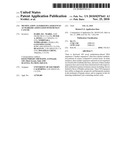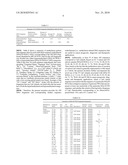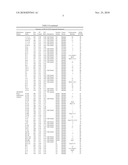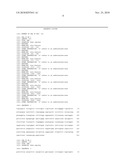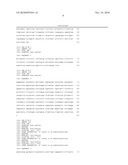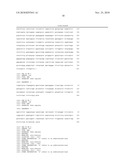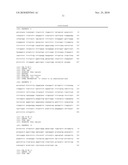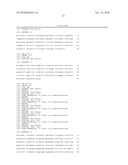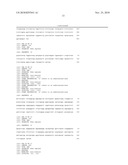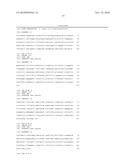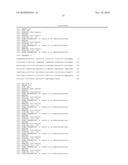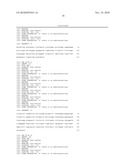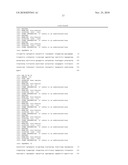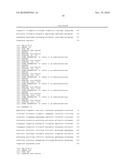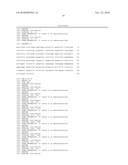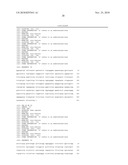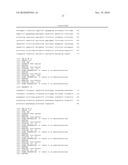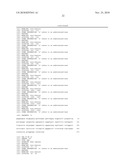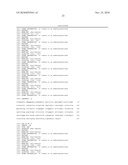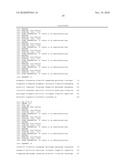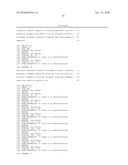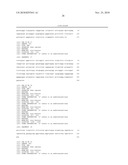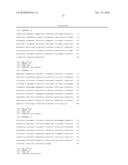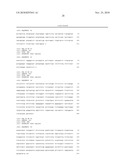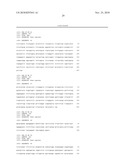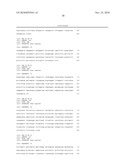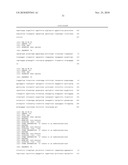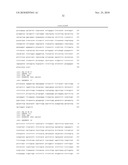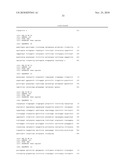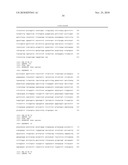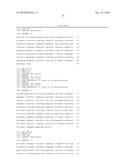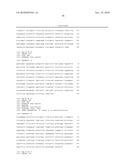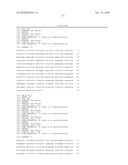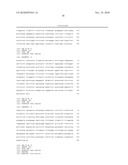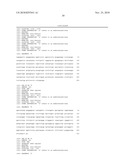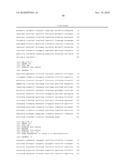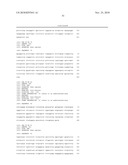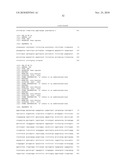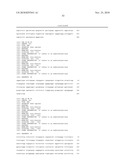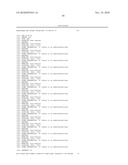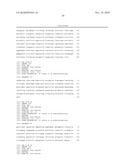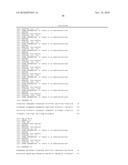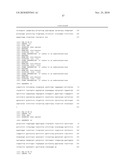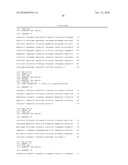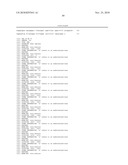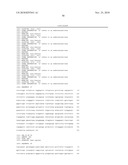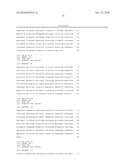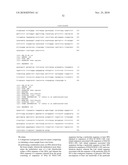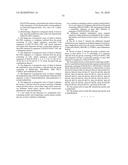Patent application title: METHYLATION ALTERED DNA SEQUENCES AS MARKERS ASSOCIATED WITH HUMAN CANCER
Inventors:
Isabel D.c. Markl (San Francisco, CA, US)
Peter A. Jones (La Canada, CA, US)
Yoshitaka Tomigahara (Osaka, JP)
Gangning Liang (Rowland Heights, CA, US)
Hualin Fu (Los Angeles, CA, US)
Jonathan Cheng (Alhambra, CA, US)
Assignees:
UNIVERSITY OF SOUTHERN CALIFORNIA
IPC8 Class: AC12Q168FI
USPC Class:
435 6
Class name: Chemistry: molecular biology and microbiology measuring or testing process involving enzymes or micro-organisms; composition or test strip therefore; processes of forming such composition or test strip involving nucleic acid
Publication date: 2010-11-25
Patent application number: 20100297641
Claims:
1. A diagnostic or prognostic assay for cancer, comprising:(a) obtaining a
tissue sample from a test tissue;(b) performing a methylation assay on
DNA derived from the tissue sample, wherein the methylation assay
determines the methylation state of a CpG dinucleotide within a DNA
sequence of the DNA, and wherein the DNA sequence is a sequence selected
from the group consisting of sequences of SEQ ID NOS:1-103, sequences
having a nucleotide sequence at least 90% identical to sequences of SEQ
ID NOS:1-103, CpG island sequences associated with sequences of SEQ ID
NOS:1-103, CpG island sequences associated with sequences having a
nucleotide sequence at least 90% identical to sequences of SEQ ID
NOS:1-103, and combinations thereof, wherein the CpG island sequence
associated with the sequence of the particular SEQ ID NO is that
contiguous sequence of genomic DNA that encompasses at least one
nucleotide of the particular SEQ ID NO sequence, and satisfies the
criteria of having both a frequency of CpG dinucleotides corresponding to
an Observed/Expected Ratio >0.6, and a GC Content >0.5; and(c)
determining a diagnosis or prognosis based, at least in part, upon the
methylation state of the CpG dinucleotide within the DNA sequence.
2. The diagnostic or prognostic assay of claim 1 wherein the DNA sequence is a sequence selected from the group consisting of CpG island sequences associated with sequences of SEQ ID NOS:1-103, CpG island sequences associated with sequences having a nucleotide sequence at least 90% identical to sequences of SEQ ID NOS:1-103, and combinations thereof.
3. The diagnostic or prognostic assay of claim 2 wherein the DNA sequence is a sequence selected from the group consisting of CpG island sequences associated with sequences of SEQ ID NOS: 2, 4, 6, 7, 9-16, 19, 20, 22-33, 35-43, 48, 51-55, 59, 60, 64, 71, 76, 78-81, 84 and 87-90, and combinations thereof.
4. The diagnostic or prognostic assay of claim 1 wherein the methylation assay procedure is selected from the group consisting of MethyLight, MS-SNuPE, MSP MCA, COBRA, and combinations thereof.
5. The diagnostic or prognostic assay of claim 1 wherein the methylation state of the CpG dinucleotide within the DNA sequence is that of hypermethylation, hypomethylation or normal methylation.
6. The diagnostic or prognostic assay of claim 1 wherein the cancer is selected from the group consisting of bladder cancer, prostate cancer, colon cancer, lung cancer, renal cancer, leukemia, breast cancer, uterine cancer, astrocytoma, glioblastoma, and neuroblastoma.
7. A kit useful for the detection of a methylated CpG-containing nucleic acid comprising a carrier means containing one or more containers comprising:(a) a container containing a probe or primer which hybridizes to any region of a sequence selected from the group consisting of SEQ ID NOS:1-103, and sequences having a nucleotide sequence at least 90% identical to sequences of SEQ ID NOS:1-103; and(b) additional standard methylation assay reagents required to affect detection of methylated CpG-containing nucleic acid based, at least in part, on the probe or primer.
8. The kit of claim 7, wherein the additional standard methylation assay reagents are standard reagents for performing a methylation assay from the group consisting of MethyLight, MS-SNuPE, MSP MCA, COBRA, and combinations thereof.
9. The kit of claim 7, wherein the probe or primer comprises at least about 12 to 15 nucleotides of a sequence selected from the group consisting of SEQ ID NOS:1-103, and sequences having a nucleotide sequence at least 90% identical to sequences of SEQ ID NOS:1-103.
10. An isolated nucleic acid molecule comprising a methylated or unmethylated polynucleotide sequence selected from the group consisting of SEQ ID NO:1, SEQ ID NO:5, SEQ ID NO:6, SEQ ID NO:10, SEQ ID NO:12, SEQ ID NO:13, SEQ ID NO:18, SEQ ID NO:24, SEQ ID NO:25, SEQ ID NO:32, SEQ ID NO:34, SEQ ID NO:37, SEQ ID NO:38, SEQ ID NO:42, SEQ ID NO:44, SEQ ID NO:51, SEQ ID NO:52, SEQ ID NO:62, SEQ ID NO:64, SEQ ID NO:65, SEQ ID NO:68, SEQ ID NO:69, SEQ ID NO:70, SEQ ID NO:71, SEQ ID NO:74, SEQ ID NO:76, SEQ ID NO:82, SEQ ID NO:83, SEQ ID NO:84, SEQ ID NO:86, SEQ ID NO:90, SEQ ID NO:92, SEQ ID NO:97, and SEQ ID NO:100.
11. The nucleic acid of claim 10, wherein the nucleic acid is methylated.
12. The nucleic acid of claim 10, wherein the nucleic acid is unmethylated.
Description:
CROSS-REFERENCE TO RELATED APPLICATIONS
[0001]This application is a continuation of U.S. patent application Ser. No. 09/699,243 filed Oct. 27, 2000 (issued as ______).
TECHNICAL FIELD OF THE INVENTION
[0002]The present invention relates to novel human DNA sequences that exhibit altered methylation patterns (hypermethylation or hypomethylation) in cancer patients. These novel methylation-altered DNA sequences are useful as diagnostic, prognostic and therapeutic markers for human cancer.
BACKGROUND
[0003]The identification of early genetic changes in tumorigenesis is a primary focus in molecular cancer research. Characterization of the nature and pattern of cancer-associated genetic alterations will allow for early detection, diagnosis and treatment of cancer. Such genetic alterations in vertebrates fall generally into one of three categories: gain or loss of genetic material; mutation of genetic material; or methylation at cytosine residues in CpG dinucleotides within "CpG islands." Among these, DNA methylation is uniquely reversible, and changes in methylation state are known to affect gene expression (e.g., transcriptional initiation of genes where CpG islands located at or near the promoter region) or genomic stability.
[0004]Methylation of CpG dinucleotides within CpG islands. DNA, in higher order eukaryotic organisms, is methylated only at cytosine residues located 5' to guanosine residues in CpG dinucleotides. This covalent modification of the C-5 position of the cytosine base by the enzyme DNA (cytosine-5)-methyltransferase results in the formation of 5-methylcytosine (5-mCyt), and gives this base unique properties (e.g., susceptibility to undergo spontaneous deamination). This enzymatic conversion is the only epigenetic modification of DNA known to exist in vertebrates, and is essential for normal embryonic development (Bird, A. P., Cell 70:5-8, 1992; Laird & Jaenisch, Human Molecular Genetics 3:1487-1495, 1994; Li et al., Cell 69:915-926, 1992).
[0005]The presence of 5-mCyt at CpG dinucleotides has resulted in the 5-fold depletion of this sequence in the genome during the course of vertebrate evolution (Schroderet & Gartler, Proc. Nat. Acad. Sci. USA 89:957-961, 1992), presumably due to spontaneous deamination of 5-mCyt to Thymidine. Certain areas of the genome, however, do not show such depletion, and are referred to as "CpG islands" (Bird, A. P., Nature 321:209-213, 1986; Gardiner-Garden & Frommer, J. Mol. Biol. 196:261-282, 1987). These CpG islands comprise only approximately 1% of the vertebrate genome, yet account for about 15% of the total number of genomic CpG dinucleotides (Antequera & Bird, Proc. Nat. Acad. Sci. USA 90:11995-11999, 1993). CpG islands contain the expected (i.e., the non-evolutionarily depleted) frequency of CpGs (with an Observed/Expected Ratio1>0.6), are GC-rich (with a GC Content2>0.5) and are typically between about 0.2 to about 1 kb in length. 1 Calculated as: [number of CpG sites/(number of C bases×number of G bases)]×band length for each fragment.2 Calculated as: (number of C bases+number of G bases)/band length for each fragment.
[0006]Methylation within CpG islands affects gene expression. CpG islands are located upstream of many housekeeping and tissue-specific genes, but may also extend into gene coding regions (Cross & Bird, Current Opinions in Genetics and Development 5:309-314, 1995; Larsen et al., Genomics 13:1095-1107, 1992). The methylation of cytosines within CpG islands in somatic tissues is believed to affect gene expression. Methylation has been inversely correlated with gene activity and may lead to decreased gene expression by a variety of mechanisms including inhibition of transcription initiation (Bird, A. P., Nature 321:209-213, 1986; Delgado et al., EMBO Journal 17:2426-2435, 1998), disruption of local chromatin structure (Counts & Goodman, Molecular Carcinogenesis 11:185-188, 1994; Antequera et al., Cell 62:503-514, 1990), and recruitment of proteins that interact specifically with methylated sequences and thereby directly or indirectly prevent transcription factor binding (Bird, A. P., Cell 70:5-8, 1992; Counts & Goodman, Molecular Carcinogenesis 11:185-188, 1994; Cedar, H., Cell 53:3-4, 1988). Many studies have demonstrated the effect of methylation of CpG islands on gene expression (e.g., the CDKN2A/p16 gene; Gonzalez-Zulueta et al., Cancer Research 55:4531-4535, 1995), but most CpG islands on autosomal genes remain unmethylated in the germline, and methylation of these islands is usually independent of gene expression. Tissue-specific genes are typically unmethylated in the respective target organs but are methylated in the germline and in non-expressing adult tissues, while CpG islands of constitutively expressed housekeeping genes are normally unmethylated in the germline and in somatic tissues.
[0007]Methylation within CpG islands affects the expression of genes involved in cancer. Data from a group of studies show the presence of altered methylation in cancer cells relative to non-cancerous cells. These studies show not only alteration of the overall genomic levels of DNA methylation, but also changes in the distribution of methyl groups. For example, abnormal methylation of CpG islands that are associated with tumor suppressor genes or oncogenes within a cell may cause altered gene expression. Such altered gene expression may provide a population of cells with a selective growth advantage and thereby result in selection of these cells to the detriment of the organism (i.e., cancer).
[0008]Insufficient correlative data. Unfortunately, the mere knowledge of the basic existence of altered methylation of CpG dinucleotides within CpG islands of cancer cells relative to normal cells, or of the fact that in particular instances such methylation changes result in altered gene expression (or chromatin structure or stability), is inadequate to allow for effective diagnostic, prognostic and therapeutic application of this knowledge. This is because only a limited number of CpG islands have been characterized, and thus there is insufficient knowledge, as to which particular CpG islands, among many, are actually involved in, or show significant correlation with cancer or the etiology thereof. Moreover, complex methylation patterns, involving a plurality of methylation-altered DNA sequences, including those that may have the sequence composition to qualify as CpG islands, may exist in particular cancers.
[0009]Therefore there is a need in the art to identify and characterize specific methylation altered DNA sequences, and to correlate them with cancer to allow for their diagnostic, prognostic and therapeutic application.
SUMMARY OF THE INVENTION
[0010]The present invention provides for a diagnostic or prognostic assay for cancer, comprising: obtaining a tissue sample from a test tissue; performing a methylation assay on DNA derived from the tissue sample, wherein the methylation assay determines the methylation state of a CpG dinucleotide within a DNA sequence of the DNA, and wherein the DNA sequence is a sequence selected from the group consisting of sequences of SEQ ID NOS:1-103, sequences having a nucleotide sequence at least 90% identical to sequences of SEQ ID NOS:1-103, CpG island sequences associated with sequences of SEQ ID NOS:1-103, CpG island sequences associated with sequences having a nucleotide sequence at least 90% identical to sequences of SEQ ID NOS:1-103, and combinations thereof, wherein the CpG island sequence associated with the sequence of the particular SEQ ID NO is that contiguous sequence of genomic DNA that encompasses at least one nucleotide of the particular SEQ ID NO sequence, and satisfies the criteria of having both a frequency of CpG dinucleotides corresponding to an Observed/Expected Ratio >0.6, and a GC Content >0.5; and determining a diagnosis or prognosis based, at least in part, upon the methylation state of the CpG dinucleotide within the DNA sequence. Preferably, the DNA sequence is a sequence selected from the group consisting of CpG island sequences associated with sequences of SEQ ID NOS:1-103, CpG island sequences associated with sequences having a nucleotide sequence at least 90% identical to sequences of SEQ ID NOS:1-103, and combinations thereof. Preferably, the DNA sequence is a sequence selected from the group consisting of CpG island sequences associated with sequences of SEQ ID NOS: 2, 4, 6, 7, 9-16, 19, 20, 22-33, 35-43, 48, 51-55, 59, 60, 64, 71, 76, 78-81, 84 and 87-90, and combinations thereof. Preferably, the methylation assay procedure is selected from the group consisting of MethyLight, MS-SnuPE (methylation-sensitive single nucleotide primer extension), MSP (methylation-specific PCR), MCA (methylated CpG island amplification), COBRA (combined bisulfite restriction analysis), and combinations thereof. Preferably, the methylation state of the CpG dinucleotide within the DNA sequence is that of hypermethylation, hypomethylation or normal methylation. Preferably, the cancer is selected from the group consisting of bladder cancer, prostate cancer, colon cancer, lung cancer, renal cancer, leukemia, breast cancer, uterine cancer, astrocytoma, glioblastoma, and neuroblastoma. Preferably, the cancer is bladder cancer, or prostate cancer.
[0011]The present invention further provides a kit useful for the detection of a methylated CpG-containing nucleic acid comprising a carrier means containing one or more containers comprising: a container containing a probe or primer which hybridizes to any region of a sequence selected from the group consisting of SEQ ID NOS:1-103, and sequences having a nucleotide sequence at least 90% identical to sequences of SEQ ID NOS:1-103; and additional standard methylation assay reagents required to affect detection of methylated CpG-containing nucleic acid based on the probe or primer. Preferably, the additional standard methylation assay reagents are standard reagents for performing a methylation assay from the group consisting of MethyLight, MS-SNuPE, MSP, MCA, COBRA, and combinations thereof. Preferably, the probe or primer comprises at least about 12 to 15 nucleotides of a sequence selected from the group consisting of SEQ ID NOS:1-103, and sequences having a nucleotide sequence at least 90% identical to sequences of SEQ ID NOS:1-103.
[0012]The present invention further provides an isolated nucleic acid molecule comprising a methylated or unmethylated polynucleotide sequence selected from the group consisting of SEQ ID NO:1, SEQ ID NO:5, SEQ ID NO:6, SEQ ID NO:10, SEQ ID NO:12, SEQ ID NO:13, SEQ ID NO:18, SEQ ID NO:24, SEQ ID NO:25, SEQ ID NO:32, SEQ ID NO:34, SEQ ID NO:37, SEQ ID NO:38, SEQ ID NO:42, SEQ ID NO:44, SEQ ID NO:51, SEQ ID NO:52, SEQ ID NO:62, SEQ ID NO:64, SEQ ID NO:65, SEQ ID NO:68, SEQ ID NO:69, SEQ ID NO:70, SEQ ID NO:71, SEQ ID NO:74, SEQ ID NO:76, SEQ ID NO:82, SEQ ID NO:83, SEQ ID NO:84, SEQ ID NO:86, SEQ ID NO:90, SEQ ID NO:92, SEQ ID NO:97, and SEQ ID NO:100. Preferably the nucleic acid is methylated. Preferably, the nucleic acid is unmethylated.
DETAILED DESCRIPTION OF THE INVENTION
Definitions
[0013]"GC Content" refers, within a particular DNA sequence, to the [(number of C bases+number of G bases)/band length for each fragment].
[0014]"Observed/Expected Ratio" ("0/E Ratio") refers to the frequency of CpG dinucleotides within a particular DNA sequence, and corresponds to the [number of CpG sites/(number of C bases×number of G bases)]×band length for each fragment.
[0015]"CpG Island" refers to a contiguous region of genomic DNA that satisfies the criteria of (1) having a frequency of CpG dinucleotides corresponding to an "Observed/Expected Ratio">0.6), and (2) having a "GC Content">0.5. CpG islands are typically, but not always, between about 0.2 to about 1 kb in length. A CpG island sequence associated with a particular SEQ ID NO sequence of the present invention is that contiguous sequence of genomic DNA that encompasses at least one nucleotide of the particular SEQ ID NO sequence, and satisfies the criteria of having both a frequency of CpG dinucleotides corresponding to an Observed/Expected Ratio >0.6), and a GC Content >0.5.
[0016]"Methylation state" refers to the presence or absence of 5-methylcytosine ("5-mCyt") at one or a plurality of CpG dinucleotides within a DNA sequence.
[0017]"Hypermethylation" refers to the methylation state corresponding to an increased presence of 5-mCyt at one or a plurality of CpG dinucleotides within a DNA sequence of a test DNA sample, relative to the amount of 5-mCyt found at corresponding CpG dinucleotides within a normal control DNA sample.
[0018]"Hypomethylation" refers to the methylation state corresponding to a decreased presence of 5-mCyt at one or a plurality of CpG dinucleotides within a DNA sequence of a test DNA sample, relative to the amount of 5-mCyt found at corresponding CpG dinucleotides within a normal control DNA sample.
[0019]"Methylation assay" refers to any assay for determining the methylation state of a CpG dinucleotide within a sequence of DNA.
[0020]"MS.AP-PCR" (Methylation-Sensitive Arbitrarily-Primed Polymerase Chain Reaction) refers to the art-recognized technology that allows for a global scan of the genome using CG-rich primers to focus on the regions most likely to contain CpG dinucleotides, and described by Gonzalgo et al., Cancer Research 57:594-599, 1997.
[0021]"MethyLight" refers to the art-recognized fluorescence-based real-time PCR technique described by Eads et al., Cancer Res. 59:2302-2306, 1999.
[0022]"Ms-SNuPE" (Methylation-sensitive Single Nucleotide Primer Extension) refers to the art-recognized assay described by Gonzalgo & Jones, Nucleic Acids Res. 25:2529-2531, 1997.
[0023]"MSP" (Methylation-specific PCR) refers to the art-recognized methylation assay described by Herman et al. Proc. Natl. Acad. Sci. USA 93:9821-9826, 1996, and by U.S. Pat. No. 5,786,146.
[0024]"COBRA" (Combined Bisulfite Restriction Analysis) refers to the art-recognized methylation assay described by Xiong & Laird, Nucleic Acids Res. 25:2532-2534, 1997.
[0025]"MCA" (Methylated CpG Island Amplification) refers to the methylation assay described by Toyota et al., Cancer Res. 59:2307-12, 1999, and in WO 00/26401A1.
Overview
[0026]The present invention provides for 103 DNA sequences (i.e., "marker sequences") having distinct methylation patterns in cancer, as compared to normal tissue. These methylation-altered DNA sequence embodiments correspond to 103 DNA fragments isolated from bladder and prostate cancer patients, and in many instances, represent novel sequences not found in the GenBank database. None of the instant sequence embodiments have previously been characterized with respect to their methylation pattern in human cancers including, but not limited to, those of the bladder and prostate. The significance of such methylation patterns lies in the value of altered fragments as potential prognostic, diagnostic and therapeutic markers in the treatment of human cancers.
Identification of Methylation-Altered Marker Sequences in Genomic DNA
[0027]The MS.AP-PCR technique was used to scan the genomes of bladder or prostate cancer patients for DNA methylation changes relative to normal individuals, because the pattern is known to be highly conserved. A total of 103 DNA sequence embodiments (methylation-altered DNA sequences; "marker sequences") were isolated and characterized as having distinct methylation patterns in cancer, as compared to normal tissue.
[0028]Methods for the Identification of Marker Sequences in Genomic DNA. There are a variety of art-recognized genome scanning methods that have been used to identify altered methylation sites in cancer cells. For example, one method involves restriction landmark genomic scanning (Kawai et al., Mol. Cell. Biol. 14:7421-7427, 1994), another involves MCA (methylated CpG island amplification; Toyota et al., Cancer Res. 59:2307-12, 1999), and yet another involves MS.AP-PCR (Methylation-Sensitive Arbitrarily-Primed Polymerase Chain Reaction; Gonzalgo et al., Cancer Res. 57:594-599, 1997), which allows for a global scan of the genome using CG-rich primers to focus on the regions most likely to contain CpG dinucleotides. The MS.AP-PCR technique used in the present invention is a rapid and efficient method to screen ("scan") for altered methylation patterns in genomic DNA and to isolate specific sequences associated with these changes.
[0029]Briefly, genomic DNA from the tissue of bladder or prostate cancer patients was prepared using standard, art-recognized methods. Restriction enzymes (e.g., HpaII) with different sensitivities to cytosine methylation in their recognition sites were used to digest these genomic DNAs prior to arbitrarily primed PCR amplification with GC-rich primers. Fragments that showed differential methylation (e.g., hypermethylation or hypomethylation, based on the methylation sensitivity of the restriction enzyme, or upon DNA sequence analysis or Ms-SNuPE analysis; Gonzalgo & Jones, Nucleic Acids Res 25:2529-2531, 1997) were cloned and sequenced after resolving the PCR products on high-resolution polyacrylamide gels. The cloned fragments were used as probes for Southern blot analysis to confirm differential methylation of these regions in the tissue. Methods for DNA cloning, sequencing, PCR, high-resolution polyacrylamide gel resolution and Southern blot analysis are well known by those of ordinary skill in the relevant art.
[0030]Results. A total of 500 DNA fragments that underwent either hypermethylation (an increase in the level of methylation relative to normal) or hypomethylation (a decrease in the level of methylation relative to normal) were isolated from the scanned patients genomic DNA. A total of 178 of these fragments were sequenced, of which 103 were novel in that they corresponded to DNA loci whose methylation pattern had not previously been characterized. The corresponding sequences are disclosed as [SEQ ID NOS:1-103], wherein for certain sequences, the letter "n" refers to an undetermined nucleotide base.
[0031]Novel marker sequences identified by MS.AP-PCR. Table I shows an overall summary of methylation patterns and sequence data corresponding to the 103 DNA fragments identified by MS.AP-PCR. A total of 103 fragments were sequenced following identification as becoming either hypermethylated (gain of methylation; noted as having a hypermethylation pattern) or hypomethylated (loss of methylation; noted as having a hypomethylation pattern) relative to normal tissue. For the fragments of each category, the "Average GC Content" is shown, calculated as (number of C bases+number of G bases)/band length for each fragment, as well as the average Observed/Expected Ratio ("O/E Ratio"), calculated as [number of CpG sites/(number of C bases×number of G bases)]×band length for each fragment. Additionally, the percent of fragments that qualify as CpG islands is listed, and corresponds to the percentage of all fragments within each category that have sequence compositions that satisfy the criteria of having a "GC Content">0.5 and an "0/E Ratio">0.6.
[0032]Thus, of these 103 fragments identified by MS.AP-PCR, 60 showed hypermethylation (Table I, upper row; Table II, [SEQ ID NOS:1-60]) while 43 showed hypomethylation (Table I, lower row; Table II, [SEQ ID NOS:61-103]). Moreover, 55 (43 hypermethylated, and 12 hypomethylated) of the 103 fragments correspond to CpG islands (i.e., fulfill the criteria of a GC content >0.5 and an Observed/Expected Ratio >0.6), whereas the other 48 (17 hypermethylated and 31 hypomethylated) fragments do not meet the criteria for CpG islands (see Table II).
TABLE-US-00001 TABLE I Summary of 103 DNA Fragments Identified by MS.AP-PCR Methylation Number of Percent that DNA Fragment Pattern (relative Fragments Average GC Average correspond to Type to normal) (103 total) Content O/E Ratio CpG Islands Hypermethylated Hyper- 60 0.54 0.72 72% Fragments methylation Hypomethylated Hypo-methylation 43 0.52 0.48 28% Fragments
[0033]Table II shows a summary of methylation pattern and sequence data for each individual sequence embodiment ([SEQ ID NOS:1-103]), corresponding to the 103 DNA fragments identified by MS.AP-PCR. Data for the 103 fragments was divided into either hypermethylated ([SEQ ID NOS:1-60]) or hypomethylated ([SEQ ID NOS:61-103]) categories. Table II also lists, for each sequence embodiment, the corresponding "Fragment Name," fragment "Size" (in base pairs; "bp"), "GC Content," Observed/Expected Ratio ("0/E Ratio"), "Description" (i.e., as a CpG island if criteria are met), "Inventor Initials" (IDCM=Isabel D. C. Markl, JC=Jonathan Cheng, GL=Gangning Liang, HF=Hualin Fu, YT=Yoshitaka Tomigahara), "Cancer Source," and "Chromosome Match" to the GenBank database. A dash ("-") indicates that no GenBank chromosome match existed, or that only a low-scoring partial match was found. Averages of the "GC Content" and "0/E Ratio," along with the percent of fragments that are CpG islands, are listed after the last member of both the hypermethylated and hypomethylated categories.
[0034]Therefore, the present invention provides for 103 DNA fragments and corresponding marker sequence embodiments (i.e., methylation-altered DNA sequences) that are useful in cancer prognostic, diagnostic and therapeutic applications.
[0035]Additionally, at least 55 of these 103 sequences correspond to CpG islands (based on GC Content and O/E ration); namely [SEQ ID NOS:2, 4, 6, 7, 9-16, 19, 20, 22-33, 35-43, 48, 51-55, 59, 60, 64, 71, 76, 78-81, 84 and 87-90]. Thus, based on the fact that the methylation state of a portion of a given CpG island is generally representative of the island as a whole, the present invention further encompassed the novel use of the 55 CpG islands associated with [SEQ ID NOS:2, 4, 6, 7, 9-16, 19, 20, 22-33, 35-43, 48, 51-55, 59, 60, 64, 71, 76, 78-81, 84 and 87-90] in cancer prognostic, diagnostic and therapeutic applications, where a CpG island sequence associated with the sequence of a particular SEQ ID NO is that contiguous sequence of genomic DNA that encompasses at least one nucleotide of the particular SEQ ID NO sequence, and satisfies the criteria of having both a frequency of CpG dinucleotides corresponding to an Observed/Expected Ratio >0.6, and a GC Content >0.5.
TABLE-US-00002 TABLE II Summary of MS.AP-PCR Fragments Sequenced Methylation Fragment Size GC O/E Inventor Cancer Chromosome [SEQ Pattern Name (bp) Content Ratio Description Initials Source Matches ID NO] Hyper- 11-1A 510 0.44 0.74 IDCM Bladder -- 1 methylation 14-3B 313 0.58 0.74 CpG Island IDCM Bladder 2 2 category 18-2B 165 0.57 0.45 IDCM Bladder 7 3 24-1B 601 0.51 0.72 CpG Island IDCM Bladder Xp11 4 26-1B 801 0.48 0.56 IDCM Bladder -- 5 26-2C 204 0.50 0.63 CpG Island IDCM Bladder -- 6 30-3D 205 0.55 1.25 CpG Island IDCM Bladder 14 7 32-3E 597 0.57 0.10 IDCM Bladder 20q12-13.1 8 34-2B 500 0.62 0.66 CpG Island IDCM Bladder 20 9 34-4B 343 0.70 0.81 CpG Island IDCM Bladder -- 10 34-5D 291 0.62 0.96 CpG Island IDCM Bladder 9 11 34-6A 266 0.64 0.93 CpG Island IDCM Bladder -- 12 35-1C 553 0.64 0.63 CpG Island IDCM Bladder -- 13 36-2D 156 0.60 0.58 CpG Island IDCM Bladder 10 14 38-1A 300 0.70 0.80 CpG Island IDCM Bladder 10 15 38-2B 196 0.56 0.89 CpG Island IDCM Bladder 15 16 7-8E 299 0.59 0.39 IDCM Bladder 17q21-22 17 83-4B 363 0.54 0.49 IDCM Bladder -- 18 84-1D 322 0.55 0.90 CpG Island IDCM Bladder 7 19 101-3E 255 0.57 0.83 CpG Island IDCM Bladder 17 20 M1-5A 406 0.45 0.96 IDCM Bladder 1 21 U2-8E 210 0.56 0.61 CpG Island IDCM Bladder 2 22 U12-1A 310 0.56 0.81 CpG Island IDCM Bladder 2 23 U7-4A 305 0.59 0.80 CpG Island IDCM Bladder -- 24 NU9-5A 379 0.67 0.83 CpG Island JC Bladder -- 25 3-17-8-B 625 0.48 0.72 CpG Island GL Bladder 18 26 4-10-4-A 499 0.55 0.30 CpG Island GL Bladder 7 27 1-1-1-A 561 0.58 0.98 CpG Island GL Bladder 20 28 3-17-8-A 717 0.50 0.68 CpG Island GL Bladder 17 29 G145-H 280 0.50 1.10 CpG Island GL Bladder 11 30 1-1-1-D 270 0.50 0.60 CpG Island GL Bladder 2 31 1-1-1-C 347 0.65 1.25 CpG Island GL Bladder -- 32 G178-A 342 0.55 0.85 CpG Island GL Bladder 2 33 34-A 370 0.62 0.44 HF Prostate -- 34 34-D 213 0.53 0.74 CpG Island HF Prostate 2 35 35-D 173 0.56 0.66 CpG Island HF Prostate 3 36 36-A 369 0.67 0.70 CpG Island HF Prostate -- 37 40-A 123 0.60 1.16 CpG Island HF Prostate -- 38 91-1 450 0.64 0.86 CpG Island YT Bladder 5 or 16q24.3 39 93-2 593 0.51 0.68 CpG Island YT Bladder Xp11 40 93-3 457 0.52 0.94 CpG Island YT Bladder Xp22.1-22.3 41 94-8 211 0.66 0.96 CpG Island YT Bladder -- 42 95-5 141 0.63 0.79 CpG Island YT Bladder 14 43 97-5 559 0.56 0.40 YT Bladder -- 44 98-1 433 0.46 0.96 YT Bladder 1 45 100-1 487 0.59 0.58 YT Bladder 14 46 100-2 403 0.60 0.47 YT Bladder 3 47 100-6 155 0.57 0.99 CpG Island YT Bladder 20 48 4-2 256 0.57 0.40 YT Bladder 7 49 5-8 224 0.47 0.96 YT Bladder 5 50 6-4 313 0.70 0.82 CpG Island YT Bladder -- 51 7-6 385 0.70 0.88 CpG Island YT Bladder -- 52 13-3 307 0.59 0.89 CpG Island YT Bladder 10 53 15-2 182 0.62 0.92 CpG Island YT Bladder 13 54 23-2 523 0.54 0.87 CpG Island YT Bladder Xp22.1-22.3 55 39-2 795 0.46 0.64 YT Bladder 13 56 40-2 438 0.62 0.51 YT Bladder 10 57 41-3 611 0.47 0.70 YT Bladder 18 58 105-4 291 0.58 0.71 CpG Island YT Bladder 5 59 107-8 226 0.53 0.96 CpG Island YT Bladder 11 60 AVERAGE 0.54 0.72 72% islands Hypo- 14-2B 580 0.55 0.51 IDCM Bladder 2 61 methylation 16-1B 633 0.56 0.39 IDCM Bladder -- 62 category 18-1B 703 0.45 0.35 IDCM Bladder 17 63 19-1B 420 0.66 0.87 CpG Island IDCM Bladder -- 64 20-1B 496 0.61 0.59 IDCM Bladder -- 65 21-2C 637 0.60 0.33 IDCM Bladder 9q34 66 29-1A 595 0.55 0.27 IDCM Bladder Xp11.23 67 29-2B 580 0.47 0.77 IDCM Bladder -- 68 32-1A 589 0.59 0.48 IDCM Bladder -- 69 34-1B 450 0.42 0.46 IDCM Bladder -- 70 34-3B 432 0.70 0.61 CpG Island IDCM Bladder -- 71 32-2B 748 0.47 0.24 IDCM Bladder 2 72 32-4B 599 0.57 0.15 IDCM Bladder 20q12-13.1 73 32-5B 614 0.58 0.20 IDCM Bladder -- 74 33-1A 552 0.54 0.32 IDCM Bladder 10 75 5-1E 501 0.61 1.04 CpG Island IDCM Bladder -- 76 6-1A 826 0.55 0.36 IDCM Bladder 22q13.32-13.33 77 7-5D 433 0.59 0.85 CpG Island IDCM Bladder 5 78 8-7C 424 0.58 0.83 CpG Island IDCM Bladder 5 79 30-6D 285 0.63 0.72 CpG Island IDCM Bladder 1 80 66-2E 401 0.54 0.82 CpG Island IDCM Bladder 16 81 78-1C 268 0.54 0.41 IDCM Bladder -- 82 97-2E 989 0.53 0.16 IDCM Bladder -- 83 M1-8C 250 0.64 0.99 CpG Island IDCM Bladder -- 84 M2-5A 402 0.50 0.45 IDCM Bladder 5 85 M1-4P 595 0.43 0.41 IDCM Bladder -- 86 M12-10A 304 0.53 0.76 CpG Island IDCM Bladder 7 87 M12-12C 296 0.51 0.64 CpG Island IDCM Bladder 17 88 M2-8M 220 0.67 0.62 CpG Island IDCM Bladder 6q27 89 NU4-3A 273 0.63 1.02 CpG Island JC Bladder -- 90 NU5-2A 361 0.44 0.73 JC Bladder 6q14.3-15 91 88-5 462 0.62 0.39 YT Bladder -- 92 90-1 591 0.66 0.45 YT Bladder 19 93 91-3 279 0.58 0.45 YT Bladder 5 or 16q24.3 94 91-4 351 0.55 0.30 YT Bladder 18q23 95 91-7 171 0.61 0.59 YT Bladder 11 96 89-3 743 0.55 0.43 YT Bladder -- 97 94-2 589 0.53 0.41 YT Bladder 22q13.31-13.32 98 94-3 538 0.53 0.49 YT Bladder 5 or 18 99 94-4 486 0.61 0.57 YT Bladder -- 100 94-5 450 0.60 0.45 YT Bladder 1p36.2-36.3 101 94-6 292 0.58 0.32 YT Bladder 8 or 9 102 96-4 395 0.63 0.54 YT Bladder 9 103 AVERAGE 0.52 0.48 28% islands
[0036]Diagnostic and Prognostic Assays for Cancer. The present invention provides for diagnostic and prognostic cancer assays based on determination of the methylation state of one or more of the disclosed 103 methylation-altered DNA sequence embodiments. Typically, such assays involve obtaining a tissue sample from a test tissue, performing a methylation assay on DNA derived from the tissue sample, and making a diagnosis or prognosis based thereon.
[0037]The methylation assay is used to determine the methylation state of one or a plurality of CpG dinucleotide within a DNA sequence of the DNA sample. According to the present invention, possible methylation states include hypermethylation and hypomethylation, relative to a normal state (i.e., non-cancerous control state). Hypermethylation and hypomethylation refer to the methylation states corresponding to an increased or decreased, respectively, presence 5-methylcytosine ("5-mCyt") at one or a plurality of CpG dinucleotides within a DNA sequence of the test sample, relative to the amount of 5-mCyt found at corresponding CpG dinucleotides within a normal control DNA sample.
[0038]A diagnosis or prognosis is based, at least in part, upon the determined methylation state of the sample DNA sequence compared to control data obtained from normal, non-cancerous tissue.
[0039]Methylation Assay Procedures. Various methylation assay procedures are known in the art, and can be used in conjunction with the present invention. These assays allow for determination of the methylation state of one or a plurality of CpG dinucleotides (e.g., CpG islands) within a DNA sequence. Such assays involve, among other techniques, DNA sequencing of bisulfite-treated DNA, PCR (for sequence-specific amplification), Southern blot analysis, use of methylation-sensitive restriction enzymes, etc.
[0040]For example, genomic sequencing has been simplified for analysis of DNA methylation patterns and 5-methylcytosine distribution by using bisulfite treatment (Frommer et al., Proc. Natl. Acad. Sci. USA 89:1827-1831, 1992). Additionally, restriction enzyme digestion of PCR products amplified from bisulfite-converted DNA is used, e.g., the method described by Sadri & Hornsby (Nucl. Acids Res. 24:5058-5059, 1996), or COBRA (Combined Bisulfite Restriction Analysis) (Xiong & Laird, Nucleic Acids Res. 25:2532-2534, 1997).
[0041]COBRA. COBRA analysis is a quantitative methylation assay useful for determining DNA methylation levels at specific gene loci in small amounts of genomic DNA (Xiong & Laird, Nucleic Acids Res. 25:2532-2534, 1997). Briefly, restriction enzyme digestion is used to reveal methylation-dependent sequence differences in PCR products of sodium bisulfite-treated DNA. Methylation-dependent sequence differences are first introduced into the genomic DNA by standard bisulfite treatment according to the procedure described by Frommer et al. (Proc. Natl. Acad. Sci. USA 89:1827-1831, 1992). PCR amplification of the bisulfite converted DNA is then performed using primers specific for the interested CpG islands, followed by restriction endonuclease digestion, gel electrophoresis, and detection using specific, labeled hybridization probes. Methylation levels in the original DNA sample are represented by the relative amounts of digested and undigested PCR product in a linearly quantitative fashion across a wide spectrum of DNA methylation levels. In addition, this technique can be reliably applied to DNA obtained from microdissected paraffin-embedded tissue samples. Typical reagents (e.g., as might be found in a typical COBRA-based kit) for COBRA analysis may include, but are not limited to: PCR primers for specific gene (or methylation-altered DNA sequence or CpG island); restriction enzyme and appropriate buffer; gene-hybridization oligo; control hybridization oligo; kinase labeling kit for oligo probe; and radioactive nucleotides. Additionally, bisulfite conversion reagents may include: DNA denaturation buffer; sulfonation buffer; DNA recovery regents or kit (e.g., precipitation, ultrafiltration, affinity column); desulfonation buffer; and DNA recovery components.
[0042]Preferably, assays such as "MethyLight" (a fluorescence-based real-time PCR technique) (Eads et al., Cancer Res. 59:2302-2306, 1999), Ms-SNuPE (Methylation-sensitive Single Nucleotide Primer Extension) reactions (Gonzalgo & Jones, Nucleic Acids Res. 25:2529-2531, 1997), methylation-specific PCR ("MSP"; Herman et al., Proc. Natl. Acad. Sci. USA 93:9821-9826, 1996; U.S. Pat. No. 5,786,146), and methylated CpG island amplification ("MCA"; Toyota et al., Cancer Res. 59:2307-12, 1999) are used alone or in combination with other of these methods.
[0043]MethyLight. The MethyLight assay is a high-throughput quantitative methylation assay that utilizes fluorescence-based real-time PCR (TaqMan®) technology that requires no further manipulations after the PCR step (Eads et al., Cancer Res. 59:2302-2306, 1999). Briefly, the MethyLight process begins with a mixed sample of genomic DNA that is converted, in a sodium bisulfite reaction, to a mixed pool of methylation-dependent sequence differences according to standard procedures (the bisulfite process converts unmethylated cytosine residues to uracil). Fluorescence-based PCR is then performed either in an "unbiased" (with primers that do not overlap known CpG methylation sites) PCR reaction, or in a "biased" (with PCR primers that overlap known CpG dinucleotides) reaction. Sequence discrimination can occur either at the level of the amplification process or at the level of the fluorescence detection process, or both.
[0044]The MethyLight may assay be used as a quantitative test for methylation patterns in the genomic DNA sample, wherein sequence discrimination occurs at the level of probe hybridization. In this quantitative version, the PCR reaction provides for unbiased amplification in the presence of a fluorescent probe that overlaps a particular putative methylation site. An unbiased control for the amount of input DNA is provided by a reaction in which neither the primers, nor the probe overlie any CpG dinucleotides. Alternatively, a qualitative test for genomic methylation is achieved by probing of the biased PCR pool with either control oligonucleotides that do not "cover" known methylation sites (a fluorescence-based version of the "MSP" technique), or with oligonucleotides covering potential methylation sites.
[0045]The MethyLight process can by used with a "TaqMan®" probe in the amplification process. For example, double-stranded genomic DNA is treated with sodium bisulfite and subjected to one of two sets of PCR reactions using TaqMan® probes; e.g., with either biased primers and TaqMan® probe, or unbiased primers and TaqMan® probe. The TaqMan® probe is dual-labeled with fluorescent "reporter" and "quencher" molecules, and is designed to be specific for a relatively high GC content region so that it melts out at about 10° C. higher temperature in the PCR cycle than the forward or reverse primers. This allows the TaqMan® probe to remain fully hybridized during the PCR annealing/extension step. As the Taq polymerase enzymatically synthesizes a new strand during PCR, it will eventually reach the annealed TaqMan® probe. The Taq polymerase 5' to 3' endonuclease activity will then displace the TaqMan® probe by digesting it to release the fluorescent reporter molecule for quantitative detection of its now unquenched signal using a real-time fluorescent detection system.
[0046]Typical reagents (e.g., as might be found in a typical MethyLight-based kit) for MethyLight analysis may include, but are not limited to: PCR primers for specific gene (or methylation-altered DNA sequence or CpG island); TaqMan® probes; optimized PCR buffers and deoxynucleotides; and Taq polymerase.
[0047]Ms-SNuPE. The Ms-SNuPE technique is a quantitative method for assessing methylation differences at specific CpG sites based on bisulfite treatment of DNA, followed by single-nucleotide primer extension (Gonzalgo & Jones, Nucleic Acids Res. 25:2529-2531, 1997). Briefly, genomic DNA is reacted with sodium bisulfite to convert unmethylated cytosine to uracil while leaving 5-methylcytosine unchanged. Amplification of the desired target sequence is then performed using PCR primers specific for bisulfite-converted DNA, and the resulting product is isolated and used as a template for methylation analysis at the CpG site(s) of interest. Small amounts of DNA can be analyzed (e.g., microdissected pathology sections), and it avoids utilization of restriction enzymes for determining the methylation status at CpG sites. Typical reagents (e.g., as might be found in a typical Ms-SNuPE-based kit) for Ms-SNuPE analysis may include, but are not limited to: PCR primers for specific gene (or methylation-altered DNA sequence or CpG island); optimized PCR buffers and deoxynucleotides; gel extraction kit; positive control primers; Ms-SNuPE primers for specific gene; reaction buffer (for the Ms-SNuPE reaction); and radioactive nucleotides. Additionally, bisulfite conversion reagents may include: DNA denaturation buffer; sulfonation buffer; DNA recovery regents or kit (e.g., precipitation, ultrafiltration, affinity column); desulfonation buffer; and DNA recovery components.
[0048]MSP. MSP (methylation-specific PCR) allows for assessing the methylation status of virtually any group of CpG sites within a CpG island, independent of the use of methylation-sensitive restriction enzymes (Herman et al. Proc. Natl. Acad. Sci. USA 93:9821-9826, 1996; U.S. Pat. No. 5,786,146). Briefly, DNA is modified by sodium bisulfite converting all unmethylated, but not methylated cytosines to uracil, and subsequently amplified with primers specific for methylated versus unmethylated DNA. MSP requires only small quantities of DNA, is sensitive to 0.1% methylated alleles of a given CpG island locus, and can be performed on DNA extracted from paraffin-embedded samples. Typical reagents (e.g., as might be found in a typical MSP-based kit) for MSP analysis may include, but are not limited to: methylated and unmethylated PCR primers for specific gene (or methylation-altered DNA sequence or CpG island), optimized PCR buffers and deoxynucleotides, and specific probes.
[0049]MCA. The MCA technique is a method that can be used to screen for altered methylation patterns in genomic DNA, and to isolate specific sequences associated with these changes (Toyota et al., Cancer Res. 59:2307-12, 1999). Briefly, restriction enzymes with different sensitivities to cytosine methylation in their recognition sites are used to digest genomic DNAs from primary tumors, cell lines, and normal tissues prior to arbitrarily primed PCR amplification. Fragments that show differential methylation are cloned and sequenced after resolving the PCR products on high-resolution polyacrylamide gels. The cloned fragments are then used as probes for Southern analysis to confirm differential methylation of these regions. Typical reagents (e.g., as might be found in a typical MCA-based kit) for MCA analysis may include, but are not limited to: PCR primers for arbitrary priming Genomic DNA; PCR buffers and nucleotides, restriction enzymes and appropriate buffers; gene-hybridization oligos or probes; control hybridization oligos or probes.
[0050]Kits for Detection of Methylated CpG-containing Nucleic Acid. The reagents required to perform one or more art-recognized methylation assays (including those identified above) are combined with primers or probes comprising the sequences of SEQ ID NOS:1-103, or portions thereof, to determine the methylation state of CpG-containing nucleic acids.
For example, the MethyLight, Ms-SNuPE, MCA, COBRA, and MSP methylation assays could be used alone or in combination, along with primers or probes comprising the sequences of SEQ ID NOS:1-103, or portions thereof, to determine the methylation state of a CpG dinucleotide within a genomic sequence corresponding to SEQ ID NOS:1-103, or to CpG island sequences associated with sequences of SEQ ID NOS:1-103, where the CpG island sequence associated with the sequence of the particular SEQ ID NO is that contiguous sequence of genomic DNA that encompasses at least one nucleotide of the particular SEQ ID NO sequence, and satisfies the criteria of having both a frequency of CpG dinucleotides corresponding to an Observed/Expected Ratio >0.6, and a GC Content >0.5.
Sequence CWU
1
1031510DNAHomo sapiensmisc_feature(15)..(15)"n" refers to an undetermined
base 1ttgcaagccc ccttngctct tcctttgncc tcgcctacat attcagggga tcgcaatctc
60actcgcgaaa taatttnttt ctgtaagagg aagccgcctt tcccctctcc caccgccaag
120gtaaaggctg ctaaagtagc tcttcttgga aggaaaaata ttttaaaaag cagctgggtt
180gctctccaca agaagatggc agttttggga aaacccatta tgtgtccaaa tgccggtttc
240cttttcttgt ttaacgcttt ttagagggca aaaatgacgc tcatgtgaag cccacaggct
300cgagccaatg tcgctgggct aattatgagt ctgcttatcc cactcccaaa tatccgagac
360gactcactca naagacattt ttactcttcc aagaattgng aattcagaan cagcttcccc
420acattctaag agaaaaaaaa acttgtttaa cgggcacgtt tttgattttt ttgccgctgg
480cgaccttaat taaaagccgg gagctncnna
5102313DNAHomo sapiens 2gcactcttaa aacgcctctc tgcagtccca ggtccgcgct
ccccaagaac tggccagatc 60gcgccgggct tggcccctga caactctgcc tcctccacct
gttgcgttta ctccgtttag 120ttggctgtgc agtctctggc cccaggtgtg cttttaaaac
tcgaggaacg cgggtgttgg 180actcattcgc agcctcttgc ctctggttcc cgtgatccca
cggtggcgag cttccaggct 240cagcgaggag atctgggttt gaacattcat ctcccatgtt
actcttttct tgctcctcgc 300gtccccaagc cga
3133165DNAHomo sapiens 3gcttagcaaa tttccctttt
ttattgttgg ttttgtctgt tggctcttac cccctttcct 60tttcctgctt cccctgagtc
agcaatgctg agcccagcga agcacagggg gccaaaggga 120gagacacacg gagcgccccg
gggtccccca gcctcggcgg ccaaa 1654601DNAHomo sapiens
4ggggggagtc gtgcgtgtca gatttaggcc aggaagcgga agtcgccagc agcgagagtt
60taacctctgt gggcgcagag ggttgcgggg attcagcgcc cgggaccgtg gatctgtgca
120gggagtcata ggtgtgtgtg acatcagtgg tggaacattt tggctcgttt tcacaattca
180gtcattatcc tttctgcttt cctcctggaa gcattaaggt tgaagttttc ttctaaagat
240caaagttttg atttgttata ttagttcgga tttgtttgat ttttgtttgt gttcggtttc
300aagtgctgat ttgtaacttt tctccccccc cacacacacg ccttttgacc cctgaattat
360ttaaaagtcc attgttggag tggcaaacat cctccgagac tcaaagggca aggccatggg
420cgctttattc cggctgctgc tccaggaacg tgggaaagca gcggagtttt attctagggg
480aaggaaacaa aggcggccga gtgccagctg cacgtttggt gggatttggt catcaggggt
540ggacatgctg cccaatggag ctgtcggcag tttgacccag cttggtccgt cgcgtcccga
600a
6015801DNAHomo sapiensmisc_feature(467)..(467)"n" refers to an
undetermined base 5gagtacgcgg ggcagaacca gcgcaataca gcattctggt aggggaacta
attttgacta 60aaatatttgc caattctaat ccccaattcc tggacctccg ggtagctggc
aaggtatttt 120atgttagatg tgtctggagt aaggtgcacc ggagtatttc gacaagagac
tcaattcaat 180gcgtattaaa acttgattga gagagggaga gagagaggtc attttataaa
gaaagacctg 240tgaacactgt agattggaaa tttatgtttg caaaataaaa ggatgggttt
atcaagtgga 300tgcatttaca aaatgtggca tccaggtttc gtaaaattag ctgaattcta
cgggtaagat 360tatgaatgtg gctcataaat aattaatagg tagtgaaaaa gaatgtattt
tgcattaggc 420agtgcattca atagtatttc ggaaatgagc acttcgattt cctcggnttc
catgcgnggc 480cacctctcca gagcagggca ggcacccagg gnggtgccca cacaaacaag
cgcgtgtggg 540cattttcttg gctcgtgcgc tgaagtgcac gctgggcctt ggtgcccgca
ccctcagcct 600gggagatagg gaggtggtgc tacctgcagg ccgattgtgt ccccgccata
ggacactagt 660gggcggcaaa cctcacaaga ctcttgcagc cagccttcag cagagccagc
aaacccagcc 720gccaccgagg gaggactgct ccatgcagat ggtcaggggc tttcttctga
agacgcctcc 780cccacgatct ctcaagttca c
8016204DNAHomo sapiens 6ccggttgctg ctggaggatg ggactacgaa
ggatggggac tccgctcggc caccgctcct 60gaatggcctc taatctcggt gttaaatact
ttatgagagt atcaatacca cctaatcctt 120tgctgagaat tactgctaga aatgtagatt
ctgaggttcc gaaagtttgt ttttggttac 180cccctccagc tcctcccgcg gcaa
2047205DNAHomo sapiens 7agacctttat
cgggcgtgag tgaaatcggt cgttcgtgtt tttcgtgggt cttccaacca 60caggccgcct
gagatggttc tagtcccttt gagtatacag acccttcctg tgcattgacc 120gacacagctc
ggcccggatc ccgaaatgaa cgtttctacc ttcggaacgc tgcgtctcgg 180atccttctga
acccgcacgt cgcaa 2058597DNAHomo
sapiensmisc_feature(361)..(361)"n" refers to an undetermined base
8gaccatgaaa tcgtgtggct ctagcccctt ctgggcctct tgttggtaat gaagccactc
60taaagcgccc cctgttattc agagggctcc ccagctgcca tgatatgtgt atggggaggg
120catagcaggt ccttttgccc cggcagccat tcttctgctc acaaggggct ggctctgggg
180acagggatgt ctttgtcatc agtgaccact aatccccctc ctcattggcc tccagggctg
240ctccccttca ctctcttggt tgaagttgta ggggctgagg ttaccctgag aaacacctgt
300tcttggagcc catagaccca accttggaga tgcaggggga gccactggct gggctctgca
360ngtggggcca gctgatcccc anctgctggc acctccaggc atccacagag cttggagtcc
420cagccacatt tcctccttgg ccttagaggg agaggaagtc ctttgattgc ctagtccaag
480atccctttat ttcctgccct gggattatgg ggnagcaagc catgcccttc atgggaagct
540gttctccctt cctcggggtt gggtctggcc tcagctcggg caacagtcat gatgggc
5979500DNAHomo sapiensmisc_feature(10)..(10)"n" refers to an undetermined
base 9gccaaacgcn ataccctctg cggggtgaga atgcgggccc gcccggctcc tcccgtgagg
60ccagggcctc ctgttctcct agacacccca aggagccaac tcctccgcag aagttccccg
120cttctgctct tatttccaag cttcgcgctt tctacaaact ccctgttgcc ttgactttga
180tttccagccg tggtgagggt cagagtgaac cccggcgcgc tccccgacgg catccccgca
240caccaggata ggagaaattg gagggcctgg ggcctcgggc tccgcagtcg tcggaggaag
300aacccaccgc ggggtccgca agggaaagtg aagaggcccg ggatttttcc aaagcgctgg
360ccaggacccc gaaggaaggg gaggagtcac ctgaagccgg ggaaggcccc ttgggtgctc
420tgccttggat ccttatgttc actgactttc gcgacccctg gaggggggca aatccgcgct
480gtttccccca acttggcttc
50010343DNAHomo sapiens 10gccaacccac accagtacct gggaccgggg ggagcccggt
ccggccgcta aaccgggctg 60gctggcgcca gggctccggg aggtgcggtc cggcggggaa
gccgtgatgg gaagcgactc 120tgtccaggga gtgtccttca ccaccacact cctcacgtcc
aggcagtgat cgacggcctg 180gcggcaccct cacagcgggc ccatagcacg gggccacaca
cgtcccctga gcttagcctg 240ggcacattcg tctgccgccg agggcttaag ccagtctgca
gcccgcgccc cgtcactcgg 300acgcaagtcc gtcgtccgct ctgccacgcg gccgctaagc
cga 34311291DNAHomo sapiens 11gtcctacaca ctccgcacac
aacgcggccg gtgttaagtc tccaaacgcc ccgagagctc 60caaggaccgc gcgcgcgaag
gcgccgtagc aagtgggcac acaccagaca ccaccccggc 120gtgttccgcg ggagaagcca
gtgcacacat cctcccgcaa ggcggggttg ccagtgcaac 180acaggaatcc tgcccttttt
ctagaaaagc cccctccccc actttccctc caatacactc 240acctgcgtct caacagtttc
cttcttgcgc tacacgcggc cgctaagccg a 29112266DNAHomo sapiens
12gtccggatca gtttccccgg ccaggtcgct tcccggtctc aaccatttcg cgctctgctc
60tgtccgctgg tttgtccctg cccggttcct ctccccgggc ctgtcagcct ccgcttctct
120ggaggttcct gggactcatc tctgatccac cgtcttgcgt tctctgggcg catcgacttc
180tctccatctt cgggctcact cctgactccc tcgctgccgc ccccgggggt ttccacgcgt
240gtctctaacc gcggccgcta agccga
26613553DNAHomo sapiensmisc_feature(497)..(497)"n" refers to an
undetermined base 13gatcctggtc catcgaaacc ttgtgtgcat cggttagtgc
ttcctgggcg tttgcttcta 60gccgacgctg acagtggagt gccagaaaga gggagaggac
cgtcatggct actctgcccc 120tggtgtcacc atgcgctctc ccccggcacc ggcgaggcga
aacgtttcgc tagtccccgg 180gaggcccctc ggtcagggca gcagcatccc tgcaccctct
ccgcaggtgg tctccccgac 240gccacaggtg gccagcaggg cgcgggtggg ggcaggagcg
cctctcccct gcccaggcct 300cccgctcctt ctcggagcgc tgtggcgggg tggagagaca
gccttctaca gctagtctag 360ctcggcgcgg ttcccgtctg tggcctccta atcccacagc
cacagcgcct tcctctaacc 420tccctcggtg ggcttaaagc ctcccgttcc ttctgtctca
ttccttctgc tccctccccc 480cgaaaccccc agatganagc tgggaacctg gcnccantna
ctgagcnaac agtgttgacg 540ggccgnggcc caa
55314156DNAHomo sapiens 14gcgcacacag tgggtacaag
gatgagctcg gtgtaaggaa tggaaagccc ccagtctaaa 60ccaccgcccc ctagacacgg
gtgaaaacct gcctaaaagc taactcaggc agtgactcta 120tcacccgaag gggccctggg
ccgcggccca agccga 15615300DNAHomo
sapiensmisc_feature(117)..(117)"n" refers to an undetermined base
15gttcacagcc cataaggtgg gggtggcccg aacctgaaac ggagcctgag ccaggatcct
60gcaaccaaag tctgaagcgc cccccggtgg gggccgagag cgctgcaggc aggtggnggc
120gcggggcagg cgggcgggcg aagggagctc cggntacgca ganaacgcgg agcgccccct
180tcccacctgc gcgagggcat cctgcccggg ggaggaaagg cgggagtccg aggcgggtcg
240gattcccagc cagctccctc ctcacaggag gcggcccatt atccggcgtc gcaaagccga
30016196DNAHomo sapiens 16ggcgcccagc aggggagcga gggaggaggg tgcagaaaga
ggctccgaaa ttgggggaaa 60ctgacccgtg cttctctacc ttcggaggtg ggacagttgc
acgaagtgct agttagaccg 120gatcagttgg aactgacgga ggactgcaaa gaagaaacta
aaatagacgt cgaaagcctg 180tcctcggcgt cgcaaa
19617299DNAHomo sapiensmisc_feature(21)..(21)"n"
refers to an undetermined base 17acaccaggag aggggaagaa nccagcacct
accgacaggg gtggagctgg gtcaagaatg 60gtgtggtccc tgctttgggg gaatgctggg
gaggtagaaa gccccttcta acggggcgtc 120actgcaatta ctgcttcctc tttcccataa
aactccccct agtgtatcag aacccccaag 180gagtttcagt aagcggttct tctgttgtct
ccggctgaga ctccagggga acctcaagct 240cacatggccc tggccgggcc cctgggcagg
agcaggcgag aggtctgcgc ggccgctaa 29918363DNAHomo sapiens 18gggtatgtgt
tacacatccg agataactac acaggcatcg accctgtcca cccggggatg 60ctagaggggc
tgcgctggtt ttactccagg ccatggtgag agccaccgtg aacacagggc 120tctctcctct
gagctgcaga agctctgtgc cctgtcccct gccacaagtc acagactttc 180ttcatgtgtt
ttacctcatg ttaatgaagg agatcttctc caggggcttg atctagtggg 240aaacagagga
gggggggatt ttaaatttca gtccgtccaa ccctgtagat ctgctgtcct 300acagtaacgt
aaaggatcac caggtaaaac gctgcttctc ccggacgccg ccccgcaagc 360cga
36319322DNAHomo
sapiens 19ccggcccgtc cctcttaata tggcctcagt tccgaaaacc acagaataga
accgcggtcc 60tattccatta ttcctagctg aggtatccag gcggctcgga cctgctttga
acactctaat 120tttttcaaag taaacgcttc gggctgcagg acactcagct aagagcatca
ggggggcgcc 180aagaggcaag gggcggggat gggtggtggc tcgcctcgtg gcagaccgcc
cgcccgctcc 240caagatccaa ctacgagctt tttaactgca gcaactttaa tatacgctat
tggagctgga 300attaccgcgg ccgctaagcc ga
32220255DNAHomo sapiens 20taataagata ccaaatcggg cgagaaacga
aaagctcctg gcctccgtat ttggggccag 60agacaccgca gggagtcagg tccccgccga
caaatcggaa gaggcctgcg ggagttagcc 120agataatgct ctccctgtcc tacccgtccc
caccaatttg ccttttacct gccgcagagc 180ttgcttgaac caaaggggtt tgcggtcttc
tcctcctcaa cttgcgatcc ccaggccttc 240gcgtcccgaa gccga
25521406DNAHomo
sapiensmisc_feature(6)..(6)"n" refers to an undetermined base
21atgtgnnaag gctcgctntc catttctctt ttcctccttc tccctctctc atgtgcggtc
60tccctcaaca tccaaaccaa ccgagtgcgt ctgaggtgaa atcgtgccag acttagagac
120ggctgccagg tttctctcaa gtcttggctt aacaaaagaa agcaaattac aaaaatggaa
180attttcaaac tagcgttcag tggtattcaa atcgacgttt gggtagcgca caggcacaga
240ccgcattcgt gctattttgt gattaaaatg ataccaaaaa tacctccttg ctttggtttt
300cgtcttcgaa aacgacttct ttccttcttc taatttcccc cttacttttg ggagcggcaa
360acccctgacc actctagaat tgctaacatt tggaccggcg tcgcaa
40622210DNAHomo sapiensmisc_feature"n" refers to an undetermined base
22gcacgttcgn gcnncgtgta ccatnagctg ccaactggan gcaccnnggn aagggtgggg
60gcctcctgga gacttngggg agagggatag ccggntaaag ctcctgtcct ttctataggc
120ataagcgggt ggtcaccacg gattggggat cccgaatccc tggctccaga tagacttaat
180gaagaagcac ctggatccgg gccgcgncaa
21023310DNAHomo sapiensmisc_feature(9)..(9)"n" refers to an undetermined
base 23tcacgcttnc naaggctctg aatcctgagg gncagatctc caagaaggag ggaggctggt
60cctagttccc gaggtcctnn actaggtcta gatcactggg taaaagaagg ggagcggcan
120cacgtatggg gtaggcgctc tcactactca catctcgaga cctttgccgg cgtagggctg
180tccgggggga acgacccgcc ttttccggta tcggttgtca tggcggcgcc cagcccagcc
240tggttttttc cggtagccaa ttgaactaac aaccccgttc cctttaggac taatctgtca
300cgtcggcgca
31024305DNAHomo sapiensmisc_feature(13)..(13)"n" refers to an
undetermined base 24ctctggtctg tgntggatac gcgtgttctt ctgcggagtt
aaagggtcgg ggacgggggt 60tctggactta ccanagcaat tccagccggt gggcgtttgg
cagtcactta aggaggtagg 120gaaagcagcg agcttcaccg ggcgggctac gatgagtagc
atgacgggca gcagcagcag 180ccagcaaaag ccctcgcaaa gtgtccagct gctgcactgc
cgcggggact cccacagcac 240catgactagt tcgtgcgact ctgcancanc aaacggcttc
cgaggaacac angatcgcgg 300gggca
30525379DNAHomo sapiensmisc_feature(6)..(6)"n"
refers to an undetermined base 25aaaacncatn tgnagagcnc ntcggcagag
ncgcagctgg ctgacccagg agaaggcgcg 60ctgggtgtgg ctgggacggc caaggccgcg
gcttcccgcg tggggatgcg ctntggcgca 120aagctggtcc cggcggggcc aggcgtttgt
gggcgggtga cggggatcta gggcttccgc 180tcgngattcc tcttgggctg tctttncggg
tttggactcg cctgccaggc tgtgtgcagg 240gttcccgctg cctctggccg gcaggcgtcc
gggctgcagg tgggccggca ggcaggtgtt 300agcgggaagg gagcacaggt agcgaggtgg
gatcggcgac ctggctaggg tgtcggcaga 360atggaatgcg cggccgcta
37926625DNAHomo
sapiensmisc_feature(8)..(8)"n" refers to an undetermined base
26gggacgcnag ccagggantt tgatccgttt tgaatgaaaa gaaagagaan ccaaaccaaa
60cctntcagtc atccaaaacc ttcaggcttc cagggaggtt ttgctataat tttctctaag
120catgactgtt tctgggggag gggaaagggg tggttgtatt tactgaaaat tcaaatcgaa
180ataataaatg gccaaatttg gacacttacg gacccaaaca gttttgctca cgccagagaa
240accgagagca cagggcttgc gtgaagccta tctcggcaga aggcaacatt ctaataaagc
300ccgtgggaaa acagattaca ttttcgccat gaataagtca tgcagtgaaa aatattgcct
360acagcctgtc gacttatatt attatcacgt ttttcaactc ggcgtgagga gggagaggag
420tgttcatatt tgactaggaa ttgcaggatc gatgcaaact ccagggcagc agccagactg
480gcatatgtgg ggctctccgg ttactttctc tgtatgtcgc gggtgagagg aacagcgagg
540acaatttagc gcaaacacac gaagggtcgg atctcaaggg ggcagcgctg ggagaaaggt
600tagggctgna gagcgnanag ncaaa
62527499DNAHomo sapiensmisc_feature(2)..(2)"n" refers to an undetermined
base 27gnctccncgt tcccctcggg cggaacggag gcaactttcc ggagtctatt tttgttaaga
60caatcaactc caataactga gctgaagttt ttgtttaaaa agaaaaaaat ctgataagtg
120atgattttac ctacttgtgg acactagatt tcaattagga aggttttttt aaacggcttt
180ttgtaacttc gctgcaggaa gcaggtttgt ttctttttct tttcttttta agagaaggtg
240tatttcactg gtgcaatggc ttggcacctc cggggcctgg gaggacctca gacctcccca
300gccctgggtt tctccgtctt caagaccaac taggaagggt caagcgggga gagggagtgg
360agggtcaggt gagatctcag agctgccccg gccggccccc gtctctttct acctcctctt
420ccagagaacc agcggctcac acccttctca acgcaggaca tgctcggcgg ccaaagccga
480attctgcaga tatccatca
49928561DNAHomo sapiensmisc_feature(20)..(20)"n" refers to an
undetermined base 28gggcgattgt tattcaaacn ngntanctct ctgcggggnn
gagnaatgng ggcctcgcac 60ggctncatcc ccgtcgagcn cagggcctcc ctgttctnct
agacatncca aggagccaac 120tcctccgcag aagttccccg cttctgctct tatttccaag
cttcgcgctt tctacaaact 180ccctgttgcc ttgactttga tttccagccg tggtgagggt
cagagtgaac cccggcgcgc 240tccccgacgg catccccgca caccaggata ggagaaattg
gagggcctgg gcctcggctc 300ccgcagtcgt cggaggaaga acccaccgcg gggtccccaa
gggaaagtga agaggcccgg 360gatttttcca aagcgctgcc aggaccccga aggaagggga
ggagtcacct gaagccgggg 420aagctccttg ggtgctctcc ttggatcctt atgttcactg
actttcgcga ngccccctgg 480aggnggaaaa tccgcgctgt ttcccccaac ttaacttcac
gcggccgcta agccgaattc 540tgcngaaatc attacactng c
56129717DNAHomo sapiensmisc_feature(13)..(13)"n"
refers to an undetermined base 29actctccgcg gtntcntggt gcctcacagg
aggtggggct ccctccaccc ggtccccagg 60cctctccctc tgcccgagct tcccggtcct
gcctccttcg cctcgcctgc ctgcccgact 120ctgaaccctg ctcctcttct aactaaaagt
cagtgtttta tttcctccgc agtccaatgc 180ccgcgtttta ccttattcaa taagaagggc
ttcatttatg gcaagacagg acagccaggt 240aataagggcc tctgcacacg cgggcccatt
ggaggggcgg aactgcgaag tcttcccgga 300agagcttcct ggagagaagg ggaacgagcc
agcgtttatt gagcatctat tatactaagc 360atctgcttgg cagttcacga cggtcgcatt
ttttcatcct tacagcgatc cctattgtgt 420cgcttgcttt aaagcctcac agctcacaaa
gggctgggat ttattccaga tctctctctc 480agatgccatc tcacttccag gtgtctctgc
tgctttgaac gcgggaaacc cacgcaaagg 540agtgatttcc aaggccttct gtttggaata
tctttaatcc tccccttatt aactggaaaa 600actcccacgc atccttcagg gctcagctca
aatgtccttt atntctgcag ngaaactttc 660ccaaggaaaa ttagttacac agctaatttt
agataaattg agccagttga tagaatt 71730280DNAHomo
sapiensmisc_feature(30)..(30)"n" refers to an undetermined base
30tgatggatat ctgcagaatt cgggctttgn gacgccgggc acgcagtagg gaaaacagta
60ttaaaacgcc ctacagaaaa tctcggcgaa gtccccggag aactctggtt tctaagatca
120gctgggcgca ctttctccgg gacgtccctt cttctcggtc tcagcgcctt cctgccctca
180gccgcgccng tnttgttttg gtggcaaact gaaataagaa atggaaatat attggccttt
240gctgctgcca gggatgagag gttgttgacg tcggcgcaaa
28031270DNAHomo sapiensmisc_feature"n" refers to an undetermined base
31gnggnngnna nncggcgatg gatntnngna ganttnggtg atggatatct gcagaattcg
60gcttagcggc cgcgaacaaa gagcgaacca aaggatgctt cgaattttta aaacggaatc
120tctgcaccca aatgcaggac tggtgactta aggagctgcg aagtctgatt taccgggcct
180actctcgacc tgccccccac ccccagctca gggggacctt tttatcntga acgccagagc
240tacnnaccaa gtcgggtggc cacnnccaaa
27032347DNAHomo sapiensmisc_feature(7)..(7)"n" refers to an undetermined
base 32tttggannta ngggggcgtg gcgtggatcc agtttccccc ggccaggtcn gcttcccggt
60ctcaaccatt tcgcgctctg ctctgtccgc tggtttgtcc ctgcccggtt cctctccccg
120ggcctgtcag cctccgcttc tctggaggtt cctgggactc atctctgatc caccgtcttg
180cgttctctgg gcgcatcgac ttctctccat cttcgggctc actcctgact ccctcgctgc
240cgccccgggg gtttccacgc gtgtctctaa ccgcggccgc taagccgaat tctgcagata
300tccatcacng aantctgcag anatncatcg ncgaannnca ccgcact
34733342DNAHomo sapiensmisc_feature"n" refers to an undetermined base
33gtagggcgcc gccgtgacag attagtccta aagggaacgg ggttgttagt tcaattggct
60accggaaaaa accaggctgg gctgggcgcc cgccatgaca accgataccg gaaaaggcgg
120gtcgttcccc ccggacagcc ctacgccggc aaaggtctcg agatgtgagt agtgagagcg
180cctaccccat acngtcggcc ggctcccctt cttttaccca gtgatctaga cctagtctag
240gacctcggga actaggacca gcctccctcc ttcttggaga tctgaccctc aggattcann
300nnctttgctc acgagctcca acccnacnca tccaaannnc aa
34234370DNAHomo sapiensmisc_feature(267)..(267)"n" refers to an
undetermined base 34cattgtttac tttcgtctaa acgcggtgga agcccatgga
agaaagcggt tagcagcaag 60gcagagccct gctccctctg cagccccagc tcccagcgcc
ctgggctttc caggcacctg 120tccgggtagg ggattgaggg ccgtggccag gcccgcactt
tcctgctagc cgcagctggc 180cacatgccca tctgaccctc cgagttctcc tctaaaaatg
gggctgacag ccgctacctc 240acaaagtcca caccgggctc aacccgntgc cttcctcccc
aacaggactc tgccaccctc 300cctcaggatg cctgagggcc ccganctgca cctggccagc
cantttgtga atgaggcctg 360nggggcgntt
37035213DNAHomo sapiensmisc_feature(8)..(8)"n"
refers to an undetermined base 35aaaatacnan taaagcgatg cttcgaattt
ttaaaacgga atctctgcac ccaaatgcag 60gactggtgac ttaaggagct gcgaagtctg
atttaccggc ctactctcga cctgcccccc 120acccccagct caggggacct tttgtctgaa
cgccagagct actgaccagg tcggggggcc 180gcggcccaag ccgaattctg cagatatcca
tca 21336173DNAHomo
sapiensmisc_feature(4)..(4)"n" refers to an undetermined base
36gacnncgggt ttgtgtgtaa cagggtcagt ccccgtatct actttgcgaa agcttcgagg
60cgagcgtgaa gtcaagggct gcggtggatg ggggtaaaan gcctcctcnt cccactgcct
120gcnccgtctt ggggtaaccc ctanccccca cccggngttn cnctttaatg ctc
17337369DNAHomo sapiensmisc_feature(22)..(22)"n" refers to an
undetermined base 37tcactgtgcc gggtctctcc tncccggtcc aactccctta
cttgtcctca tctctgtccc 60caaggtccgt gacccgcgga ggtgatgggg gggataggag
agccccaggg accgcagagg 120tgacacaatc gcccgcccgt cctccctcgc tgggagccga
ttcagcctgt gccgagcctc 180tcccttcgcg tgcctctgcg cacagcggtg gcaccgcagg
actccgggtc ccccccggct 240ctccatcggg aagccggcaa atgcgcttcc tcagccagac
cgcggcgggg tgggggcggg 300gggggcggaa gttgaaatac tgggacagaa acacctgccc
gtcccaaggg acggaaaact 360ggatgccaa
36938123DNAHomo sapiensmisc_feature(20)..(20)"n"
refers to an undetermined base 38gtcccttcgc cccgcttttn ctttccccna
ggtcccagcg nccgaaccgg cggatgtcca 60cgaaacatag ggcgagccgg gggccangcg
gggccgtgta aaatctcntg tggtcatttt 120gtg
12339450DNAHomo
sapiensmisc_feature(32)..(32)"n" refers to an undetermined base
39ctagccctgg aagagaatcc gaggctcagc cntgctgcag cacccaggac actgcatccc
60agcacctgcc cgaagatcag cccaggaccc aaaggaaagc aggctccaag ctccccggaa
120gccaaggaaa ataggaaaac atatcctgcc ccggggacac cttctggaac tatgaccaca
180tgcacttgac cttccggaac aatcaccgca tgcacctgac ctcccggaac tgtcaccacc
240gcgcgcacct gacctcccgg cactgtcacg accgcgcgca cctgacctcc cggcactgtc
300atcaccgcgc gcacctcacc tcccggaact gtcaccaccg cgcgcacctg acctcccggc
360actgtcacga ccgcgcgcac ctgacctccc ggaactgtca tcaccaggcg cacctgaccc
420cccggcactg tcacgaccgc gcgcacctca
45040593DNAHomo sapiens 40ggaccaagct gggtaaactg ccgacagctc cattgggcag
catgtccacc cctgatgacc 60aaatcccacc aaacgtgcag ctggcactcg gccgcctttg
tttccttccc ctagaataaa 120actccgctgc tttcccacgt tcctggagca gcagccggaa
taaagcgccc atggccttgc 180cctttgagtc tcggaggatg tttgccactc caacaatgga
cttttaaata attcaggggt 240caaaaggcgt gtgtgtgggg ggggagaaaa gttacaaatc
agcacttgaa accgaacaca 300aacaaaaatc aaacaaatcc gaactaatat aacaaatcaa
aactttgatc tttagaagaa 360aacttcaacc ttaatgcttc caggaggaaa gcagaaagga
taatgactga attgtgaaaa 420cgagccaaaa tgttccacca ctgatgtcac acacacctat
gactccctgc acagatccac 480ggtcccgggc gctgaatccc cgcaaccctc tgcgcccaca
gaggttaaac tctcgctgct 540ggcgacttcc gcttcctggc ctaaatctga cacgcacgac
tccccccgcg gca 59341457DNAHomo sapiens 41accaccaacc aaatagggcc
tttcctgtta acgaccacgc ggcaaggggg ccgggccctc 60gcacgcctcg acggcctccc
ccactccaaa gggactccga tttcgcagga tctcccgcct 120cccgcctctg ctcccaacac
cctacgtttt tctcttcctc ctcatttacg tatttacaat 180aaaacagcga agctgcacag
tctgtctcta aatcaaacgc ggttaccatc aaagcctcag 240actctatgtc tcaaccgcaa
aaggtctgac aggaaatcaa ctcgggagtt tgtcaattct 300ttaaactcaa agctctgtta
acgaaatctg gatctttcct cgctccccac ctgcctcccc 360tgacaggaga atgactgtaa
aaggatcctg tcgtccccga aagtcagcac caagcacttc 420acaaattgtc aaatctcaaa
agcttacacg cgcggca 45742211DNAHomo sapiens
42gcctgacctg aatgacgcgc atgttgaggc cggtctcctg cgccagctgc tcgcggatgt
60ggcgggtggg cttgggtgta gcagcgaagg cggccttcag cgtctccagc tgcttggctt
120tgatggtggt gcgcggtccc cgccgcttgg cgcccaggtt ctggtcgtca ttctcgttgc
180tacccgcttc cttgtccgac acgtcggcgc a
21143141DNAHomo sapiens 43aaatcatctc cgggggccca gcacggacac gctccagacc
cgtgagttcc ccagcgccgt 60gccgggaggt caggggcgct gaaagaagga agaattcagc
cacctctcag catccctgtt 120acctcgagga cgcgcctctc a
14144559DNAHomo sapiens 44acccactttc cattaacact
aaataaaacg catccatgga tttcctctcc attccgaggc 60aacaggagtg catggcacat
tgccctactc ccctgaagct cttcgctaac ctaagactcc 120agggtgagga agttagctgg
agctttttaa agtgcatctc caaagagaat tttgctcaca 180ccatgagagc ccccaagaaa
caccagggcc cccttagatg ccggagacca cgccctccag 240gaataagccg caccctctgc
ccagcagatc cttgcgcgag tagccctctt tccctggggc 300taatcaagtg catgccacat
gtcaccactc tcagctggca attcttcctc agaggcgcag 360actttcacgg aatccccagc
agggggggtt aagagattca ggggaggccc cgcccgtgcc 420ttccacaaaa gtcgctttac
cgtggctcgt gtcctgcggc cccaaggggg tagcctggga 480cgtgtattgg gagggcatag
aggctccttc caggacaagc tgccagcctc cagtgggcaa 540ccatgtgaga ggcaaaatt
55945433DNAHomo sapiens
45gcgaacagca caaaggcttc attcctacga gagattaagt tttagagcaa atggacacga
60tcgttaaaga atttgatatt tccatgtaaa ctgcattagc aggttatgcg atccaaactc
120acaggaacaa ctccaactct cggccatgcc ctatttcatg tctagatttg tttaaccgac
180ttacatcata atccaagaat acgaactaca gtatattctt acagcaaagt tattccttaa
240aagcaaaacc gagccacctt tgaaaacacg cacacacatt atccacggca ctaaaacccc
300agtcttgacc gagaaagacc aacaacttgg gggggaagaa aacaacttca gagccagagc
360tcccaaagca gaaagcgctg gcggctgaag ggcacacgag gttccgctcc cgggcgaacg
420ggcggcgtcg caa
43346487DNAHomo sapiens 46cccttagtat tccatgagcc accattttcc ccacgatccc
tccagcctga acgatcacat 60cctactgtgg accacgactc tcccagcagc gggcgtttaa
tatccagtta gcaggttctc 120accaccccct cgctggctcg aatacagcat ctgcaccgag
ttcccgagaa tcgtcaaccc 180agcaaatccc ttaattggtg gacatgaaaa tccagggctt
tgtgctgtaa taacagagtc 240ctgggggcct ggggagtttg tgccgcttgg agctcaggtt
tctgggacag aggctgagcg 300cagggcaggg aggcaggtct cacctggcac ctcccagagt
cctcgccgag cagatggaag 360cagaggctct cgcgcccggc ccccgccggg agacctctct
ctctttccct cggcctgctc 420tgccctctcc cgccttctcc ctgtctgatc cttctctgct
gtcatgttct ttgtcctcgc 480gccccga
48747403DNAHomo sapiens 47gtcatataag cacaaccatt
cccagggcca ccctggatgc atcagatcag tccccccact 60ggtgaccaca atggctggct
cagagtgcct ttgaacagac aggagaaaca gacttcttgg 120agggagggac cttcccacag
ggaatggcca aggagctagg tcttcagggc ttgcatggcg 180tggagtgtgt gctcaggtgc
acagtgaagc aaacctgagg ggacttgggc cctgcgtcct 240ccagcacaca cgcacccttt
cgccgtcaca tccggggcac ccacccgtgg aatatgtgag 300ccgcacttgg ccagccacga
gttccagggc caggaagtcg tgcttctcgt tcaggcgccc 360gttgtagaag agcagcccgc
tctgctgcac tgtcgcgtcc cga 40348155DNAHomo sapiens
48ggcgtggaga ggagggggca gaaactcagc cgcccctacg tttgctaaac tgcgtccgcc
60agggggcgta tttttctaaa acgcacaaga cgtttcgtgg gttatcgatg gtctcttgag
120cctccttgac tgatggggat tgaccgggcg ggata
15549256DNAHomo sapiens 49tctactgagc ttttctttaa gtggaaccag aagtgctggg
atgagaggga aaggatggga 60gtgcgtccaa aggtggacag caggtcccca tccctggtgg
gagtgagact ggacggcatc 120ccccggaaag gtggtttggg ccttggacaa ggctagaggc
aggagtccat gatgcagaga 180tgacacagtg cccctccgcg tgtgagtcca cgaaggtcac
tactgaggct ttgtgcttgt 240aaaaggccgc cccgca
25650224DNAHomo sapiens 50tgcggggtcg tgggggaacc
ggcgggagct gttcgctggc cggcctcact ggagtaggaa 60ttttagatga aactgagtcc
gtttctcctt gaaggcaggc agtattctta gatctactat 120tcatttaaaa agaaggaaaa
gaaaaaaaaa tgactgctac ttactgagaa gaaaatttct 180gttctcctcc gattccgctg
atcccgcttt atccgcgcac ctca 22451313DNAHomo sapiens
51gtggctggga cggcccaggc cgcggcttcc cgcgtgggga tgcgctgtgg cgcagagctg
60gtcccggcgg ggccaggcgt ttgtgggcgg gtgacgggga tctagggctt ccgctcgtga
120ttcctcttgg gctgtctttc cgggtttgga ctcgcctgcc cggctgtgtg cagggttccc
180gctgcctctg gccggcaggc gtccgggctg caggtgggcc ggcaggcagg tgttagcggg
240aagggagcac aggtagcgag gtgggatcgg cgacctggct agggtgtcgg cagaatggaa
300tgcgcggccg cta
31352385DNAHomo sapiens 52tacgttgcgc attcattctg ccgacaccct agccggtcgc
cgatgccacc tcgctacctg 60tgctcccttc ccgctaacac ctgcctgccg gcccacctgc
agcccggacg cctgccggcc 120agaggcagcg ggaaccctgc acacagccgg gcaggcgagt
ccaaacccgg aaagacagcc 180caagaggaat cacgagcgga agccctagat ccccgtcacc
cgcccacaaa cgcctggccc 240cgccgggacc agctctgcgc cacagcgcat ccccacgcgg
gaagccgcgg cctgggccgt 300cccagccaca cccagcgcgc cttctccagg gtcagccagc
tgcggctctg ccgaagcgct 360cctccgctcc tttctcgcgc cccga
38553307DNAHomo sapiens 53aacccggctc ggttcggcaa
ggttcaggga gacaaggtag agaaggctgg ggtgagcaag 60aagtcgggcg gccgatcgtc
agggccacga gcctcgcctt gccttcttgg aatcccaccc 120aactttaaag gcccaaagat
cctgaaaatt ccgaaagcga aactgcgggc tggtctccag 180aagtttgaga acggtctccc
aggctttcca gcgtcgtccc gggattctcg gacaccacaa 240acgccatcaa ccacgagcac
cggtgtccgt ggctattgcc ccgaatggtc cccatccgcg 300tccccta
30754182DNAHomo sapiens
54cgatgtcgaa gccgtttgga gggaacagcg gtttccaagt tcctgctgac ttgagaagcc
60tctgcgggtt tccgaatctc cggcgcactc ctgggcgcgc tgcgggagct gtagctcagc
120cagccaggga gtagcggctt tcatccgccg ggaggagtct ttcgagttca atcgcggggg
180ca
18255523DNAHomo sapiens 55tcgggtttga tccgccccaa ccaaataggg cctttcctgt
taacgaccac gcggcaaggg 60ggccgggccc tcgcacgcct cgacggcctc ccccactcca
aagggactcc gatttcgcag 120gatctcccgc ctcccgcctc tgctcccaac accctacgtt
tttctcttcc tcctcattta 180cgtatttaca ataaaacagc gaagctgcac agtctgtctc
taaatcaaac gcggttacca 240tcaaagcctc agactctatg tctcaaccgc aaaaggtctg
acaggaaatc aactcgggag 300tttgtcaatt ctttaaactc aaagctctgt taacgaaatc
tggatccttc ctcgctcccc 360acctgcctcc cctgacagga gaatgactgt aaaaggatcc
tgtcgtcccc gaaagtcagc 420accaagcact tcacaaattg tcaaatctca aaagcttaca
cgcgcgggca ctccggaaag 480gctgtgggga ccacccaaag cacccccctc cacaccgcgg
gca 52356795DNAHomo
sapiensmisc_feature(526)..(526)"n" refers to an undetermined base
56tttactttct tccggctgac gtccatctcc tcaaatttct caggaatgtg gggaagctcc
60tagccctgcc tgcctttcta gagggcttct tggatttgca gcttctaaca agttgctctc
120gccacggaga agctgttatt atgacaaaat atttggggca ttatcaaaat cacacaggct
180gctgggctgc tgtcggtttc tcgccagggc cagtaagcag ttacatttgg agttgctacg
240tgttgtttgg gggccgggct gtggagagtg actgagccag tatttttcat ccaaaattct
300gcaaattgaa ttaaccacaa ttctagtctc acctcccgtc tttaaaaaaa taagttgaag
360aaaaggtaaa tattagagat aaggcagcat ctagtgactg cggagaggca caagctggtg
420ggcgagggtt gggggagtca gcaaagccct tcaaaacctc cccgtttaat tttctggctg
480tctctgcatc ctgttgccag aattccaaat gcttggagtc atttanaggt gcgagaactc
540aaacgtcgtt ccacttggaa aggggaccgt ttaacgttaa attccattag cacctaaatt
600gtttcttaaa gacatccgct cagacacagg actcgaaagc gagcatttca tgcaaataaa
660tttctcaaat tttaaacctt gttaaaagct tgtctcgcac ctcggctccc tccccttccc
720cggaaganaa caataggccg ntggcgcatc cccacttcgg antaaatatt gacgggggaa
780gttgctaaaa acatc
79557438DNAHomo sapiens 57gcctgtgtgt aggggactgg aggtggggga acctgttctt
ttcttgtgtc tgatcctggg 60gctcgcttcc tgggtcctag aacagcagcc aggacggaag
aaactgttca cgttgcaccc 120ctttctctaa gattcccagg ccaagagtag ctgcagaagg
tggccctgaa tctatggcct 180ccttctctct gcctgacccg gctagtggat ccggagaggg
gaccagggag agctcctccg 240agcaggggtc cttcgggaga cagagagggg tccaggctga
gagaactctt caagcatggc 300gagtctgcgt tatagaatcg ggcgggcggc tcaacttggg
ggaagcacca agaagagctg 360ggcgacctgg agcgcagaac cggctttggg gagccacccg
gcggggcagg ggtagcacgg 420agcccgggcc gcggccca
43858611DNAHomo sapiens 58gcttccccct tcctttctcc
cgcgctgccc ccttgagatc cgacccttcg tgtgtttgcg 60ctaaattgtc ctcgctgttc
ctctcacccg cgacatacag agaaagtaac cggagagccc 120tacatatgcc agtctggctg
ctgccctgga gtttgcatcg atcctgcaat tcctagtcaa 180atatgaacac tcctctccct
cctcacgccg agttgaaaaa cgtgataata atataagtcg 240acaggctgta ggcaatattt
ttcactgcat gacttattca tggcgaaaat gtaaactgtt 300ttcccacggg ctttattaga
atgttgcctt ctgccgagat aggcttcacg caagccctgt 360gctctcagtt tctctggcgt
gagcaaaact gtttgggtcc ataagtgtcc acatttggcc 420atttattatt tcgatttgaa
ttttcagtaa atacaaccac ccctttcccc tcccccagaa 480acagtcatgc ttagagaaaa
ttatagcaaa acctccctgg aagcctgaag gttttggatg 540actgagaggt ttggtttggt
ttctctttct tttcattcaa aacggatcaa actccctggc 600tcgcgtcccc a
61159291DNAHomo sapiens
59gagtttggca ggccccggat tccacaaagg agtaggcgcg gccagccgcc tccagccctg
60agctcagtaa attcggtgtc ctgaatgctc ccttcctgtc cttaccactg cgagctctct
120tgggacagct ttctaggttc cactgcgacc tactttccgc tccctgagtg cttctttgct
180gaaactgcag gcgaaaagat ctctttccca gaccgcagcg cactttgaga aggggctcaa
240agtcgcccgc tctgaatccg gcaccggcaa ataggagtag ccgcatgcgc a
29160226DNAHomo sapiens 60gaaaacagat aaaacgccct acagaaaatc tcggcgaagt
cccggaggac tctggtttct 60aagatcagct gggcgcactt tctccgggac gtcccttctt
ctcggtctca gcgccttcct 120gccctcagcc gcgcgcagct ttgttttggt gacaaactga
aataagaaat ggaaatatat 180tggcctttgc tgctgccagg gatgagaggt tgttgacgtc
ggcgca 22661580DNAHomo sapiens 61ctgtgatgca ctcggcggat
ctcggtggca gctgcctcct tcatctccag tgacgcctgc 60atgctgtcct aggcagtgtg
aggagtgaag atgagatttg gcgcatcttt caacggagtc 120tgagcaaagc taaagggctc
cgattcgtgc aagccaaggg ctgcccctcc tatcctgtcc 180tccttgagga cctgtgctaa
ggctttctca tccaccaggc caccatgggc tgcgttcaca 240aggaatgctc cctgtctcat
ctgctttata gtaaagtcat tgacgaggtg gtggttatgt 300tcattgagat tgctgtgcaa
cgagacacag tcactctgat acagcaaacc ctgcagggtg 360tatcagggtc ccctctgcat
gccctgggac ctctctatct tgtcctacaa gtaggggtca 420taaaatacga cgctgaatcc
aaaggccttg gctcaaactg caaccgcctg cctcatgcaa 480ccgaagccca tgaggcctag
cgtcttccac gaatgagggc cactcccatg gccacctcga 540gaatctgctc cacgctctga
acccgcgcac ctcaagccga 58062633DNAHomo sapiens
62gcccaggaga agccctccac ggtgggcgtc ctcctagaca accagcaccc cctgcaggca
60ccctcgtctg gcagaatcag ccctttccca cctgcaggcc cttctcagcg cctctgactt
120cccacacaca gcacaggtta caaactggtc cctggcagtg cactctagcg ggcctctctc
180acaagttctg cgggcctcgt ttcatggaaa gcgggttgtg gattcctgct gcccttggat
240ggcccctgcg cacgcacacc tctgagcggg cactgagcga gcgtggggag ctgctccctg
300ggaactaggc aggagctttt aaacaccctt acacacagcc attctgcggg aatacatgct
360ttcccggtaa ggcttttact gttcattcca ggtaaattgg aagtcgcaca ccccaagctc
420caaatacaac tcgttagctg gcaggtctct gaagccaatt ccttctgagg aaaatggaga
480taatagcagc taccctccca ggtgactggg ggagaataaa gtggctgtgc atagtggtgt
540ttgcagctgg tggctgctat tatccttcat tacagcttgt aaaaagggtg tctaggccat
600ttacacacag ataggccggg tggggtaagc cga
63363703DNAHomo sapiens 63gcctatgaat ggatttataa ttgctttatt tttgtcccat
ttagacagaa gtcagagaca 60gaggagagaa ccaaaaaact tggatgtttc cgtaaactag
attcgtcaat cctcgataat 120tgaaagtagt tccagtatgt cagccaccgg ggttccctgg
ggagctaacc agtcctgaag 180gaagtatgaa gaggaagagg aggtcttcag ttaaggggat
gaatttgtgc agtcctaagc 240cctgcaaagg tgctggaggg aggaagaagg gcaggaaata
aaagatggaa gaaaatttgt 300tttttatcca cttagagttt tatctttaat gatgggaaac
agtgctgctc tcaggaaact 360cagtgtggag atctaggagt tcacggttca tagtccatta
ggagcaggaa aaggatagag 420gacatttata aagtaacatc caagtccaaa gtaaaatggt
ataaattgtt tcccatgata 480aaggctggct gagtaggtca ggaaaggtct tgtcagacca
tatgtgctgt ttcaggctgc 540ttcaaattct tttaggacag tggtggatat gagtgaagac
ggggcaggca ggccacatct 600cttagaagag gaaggtgatt gccacgtctc cttcctccat
gctgatggca aggcgtgcgg 660gctgtgttct cttgcagcca gcgtcccatg ctcggcggcc
aaa 70364420DNAHomo sapiens 64gtgacgtgcg gaatacacgt
gatgtcgggg acaggagcgg gctgaagagg gcacgatccc 60acgcggaggc cacccctcac
ccggggtagg agcccgctgc acttgctgtc gctcagcccg 120ggcgctgcac cacggcagcc
gccatgctgc ttaaagccgg tcatgtgacg cgggagccag 180ggtggaaggg gtccccgcgg
gcaagccttc gacacgtgac ctgccacccg actacggaag 240cctcttgggc gttccgcccg
ggctcacatg tcatgtgacg gccggccggt cgccggagta 300accaggaact ttcccagacc
ctgcggtccc tggagcgtca aaaagagcgt ccccgtgact 360aggtggagtc gcctgccctt
ccgaatctca gctgtcttat ctggaacccc cacgcggcaa 42065496DNAHomo sapiens
65gcgctgcacc aatttagagg gtagaaaaag gagttagaag caaagaggaa aaaataaata
60aacaggcaac aaaaacccaa cccagccagc ctgagccatt tgcattagtg ttcatttagg
120aaattagcag acgggaaacg ctggggagtg gagtgggccc cggccttggg gactgcagag
180cccgctcagc cctgggtggc tgggcccaca tggctgtcgc caggagcaca ggaggaccca
240gaggtggccg agggagcctc gccgggctcc ggtatgggtc ctggcccctc acaggtgcga
300gcctggccca gtgactgtgg acgctgtggg agagcaggcc tccgatacgc agggctggga
360ctgctgacct ggaaggtggt gccgggcgtg tctggtgaag gcgccgttgg cagctagaga
420gagacggcgg atggggtgac gccataaccc acggtcccag ttttgaggct tgacggtgac
480ggaaaaggac gtcggc
49666637DNAHomo sapiensmisc_feature(612)..(612)"n" refers to an
undetermined base 66cgccgagccg ggatgagcaa ggcttcctgg aggagagggc
cggcctgagc ttggaaggat 60ggggaggagc cactggctac aagggtgtag aggtgagaac
cagtgtgacc tgcccatcgc 120tggtcgtctc tgggtcattc agctgaaatg gcatctctga
gctgagagga gtgttgcctg 180taaggagcta ggcatcagcc cccagtagag gggcggccca
ggcacagccc atagccgcag 240acttagtgag tctagctagg gagacagtag aggggccaaa
atgaggacac aggtcaccaa 300aaatcctggc caggtcctgc cactacctgg ctcagcgacc
tgcccccccg agcctcagtt 360tcccccattg gtggaatgga gtgaggaaga cgcgcctccc
ggggctgcga tggagaattg 420agtcagagtc tgggggtgct gggagggctg gggagcagcc
tccctgagcc tcagtttccc 480tggctgggga atgaggacct tgctcgtccc ccctcataag
gggaagctgt caggaaagtg 540ctttcaacgc tgagccattt cccagtggtg cacaattagc
tttccagagg attttggtgg 600attctagagc tngagggctg ggggatnggc ggccaaa
63767595DNAHomo sapiens 67gccctgagct cttgagggcc
tctgcagttc ttgggacaat tctgggacta tatctttggg 60ccttggtgag atctagaggc
tctaaagtct ttgggagggg tcctgagctc cgtggacggc 120agggtcttgg gcactcactt
gcattcttga ggggtgtgtt tggcctcgtc cgtgcaggtg 180tagaatttcc cctgtagaga
ggatgtctgt caagtaggtt cacccttcat cacactcccg 240cccagacccc tgcctggcat
tccctccagt gtttgcccca ccttgaagag ctgcaccccg 300atgcaggcga acataaattg
cagaagtgtg gtgacaatca tgatgtttcc gatggtccgg 360atggccacaa atacacactg
caccacatgc tgcgggcacc caagcatatg gctactgaac 420actacaggcc acagtggtca
tggggcaggg actctggtca tagatgcagc tgagggactt 480gggctgggga catgtggtga
tgggtcaggg atgtatggtt agcaacatgt gttcaagagg 540cagtgttatg ggctagagac
gtgtgggcat ccaccaggaa taagtgtttg ccggg 59568580DNAHomo sapiens
68gagtcaggac ggaggacgcg gcaggtcaca gagcccacca agtccgaagc tggaagttca
60gattctttga tattcaaagg tggatcatct gtgctttttt ttttttatca gtctctcact
120ttttatccat catctaattg tgacagctta tttgccttta taccataaga tggggagtag
180ggttgagatg aaatccaagc atcgtttccc ttccccgatg gtcgcctccc tggggtgaga
240cgttcgacgt gtcagacttc accaagagca tctcccgcct cggtgcagta atgaacttgg
300aaacgattta ctccggcact tggttcctgt ctccataaat gcggctgctt taaagggaat
360gtaaaaaggg ctgtaaattg gtattgattg ccggtggtct tgaagaaccc caactgagga
420ttgaccgttc cttggagtga aggctccgca ttcagacgcc tttcgcctta cgtcatcata
480attgagaagg gaaaggagac gtgttagttt cagtctgatt atttaccatc aaggcataaa
540cacttctcag aggcagcgga acccattaaa ccggcccgta
58069589DNAHomo sapiensmisc_feature(559)..(559)"n" refers to an
undetermined base 69acacgggggg caacctcttg cacctggctc cctgccctcg
gtgccacgtt tccagggttc 60ctccacgtcg caggctgtgt cagcctcgct ccttccactg
cagaattgcg gtccacagcc 120tggatgggcc actctccatg tatccacctg tccctccgtg
gctgctgggc tgagtcgctt 180ctgatgctaa caagaggcgt ccggctggac taaggccccg
gaagctgaga actggagggc 240aggtgcgggc atcgggcaga gcagctccag caggcaggac
ctggggcctc caccctgcac 300ccctgtgccc cgcgtgtggc ggaaccgccc cgaggggagg
ctgtcaccac ggtgacaggc 360agccccacgc gagcctgaga accctcagcc cacctttttc
tgtaatcaca gcaggcatct 420ctccggcaag tcaatccagt tccagctggt gctgcctccc
ttgcctcatg ggctttattt 480tagaactctg agcaataata aaaaagacgc tacccgctac
aatagatgtg gcagagaatc 540tggctcttca cttcatcana gatcaccctg aaatgatggt
tgttgttaa 58970748DNAHomo sapiensmisc_feature(10)..(10)"n"
refers to an undetermined base 70gctacatctn ctctacattc taactaacac
ttgttatttt ctgtttttgt ttgtttgttt 60ttaatagcca ttctagtagg catgaagtgg
tgtttgcctg ctttttttga tggaggtgga 120ggaatagggt ggaattggtc cttaaccatc
aattaagctg ggggccttag acctctgtga 180attggctgtg acaatagcta aaggaggctg
ctacctcata ctgaagagat gtttcctaag 240tttgtcaccg gagagggcac cgaaccaact
tattgtcttg gagggaagaa gcagcaaggc 300agaagacttg aacttctcag agaaaaaaac
agtctacaga cttcatttta tgctgtcctc 360acacactact gaaagctcta ccctggggac
ctggcttgac ttctaaccta cncctgtgtt 420atttaggaag agctcccagc tgctctgagt
ctcagtctcc caatcagtga aatggaggca 480atagcacctg cctggctgca tcgccccaca
gtgctgcaat gagcatccaa cgagagaaag 540cttgtcacct gtgttgcaaa ctaagttaca
caaatgcagg cagtagcagc tagaagaaaa 600tggttgggaa tctgaaaaga attaaagccc
cccatgaatt tcttctcacg cctcctccaa 660aagccaggga ctgcttcacc ccgcctccag
gactgctcgc tccagcattt ccggcagctg 720ctgacagaat gtatgttgcg gctgtccc
74871599DNAHomo
sapiensmisc_feature(491)..(491)"n" refers to an undetermined base
71gatgactgtt gcccgagctg aggccacgac ccaaccccga ggaagggaga acagcttccc
60atgaagggca tggctgctgc cccataatcc cagggcagga aataaaggga tcttggacta
120ggcaatcaaa ggacttcctc tccctctaag gccaaggagg aaatgtggct gggactccaa
180gctctgtgga tgcctggagg tgccagcagc tggggatcag ctggccccac ctgcagagcc
240agccagtggt ccccctgcat ctccaaggtt gggtctatgg gctccaagaa caggtgtttc
300tcagggtaac ctcagcccct acaacttcaa ccaagagagt gaaggggagc agccctggag
360gccaatgagg agggggatta gtggtcactg atgacaaaga catccctgtc cccagagcca
420gccccttgtg agcagaagaa tggctgccgg gcaaaaggac ctgctatgcc ctccccatac
480acatatcatg ncacctgggg accctctgaa taacaggggg cngctttaga gtggcttnat
540taccaacaag aggcccagaa gggctagagc acacgatttc atgntcggcc gcatgncaa
59972614DNAHomo sapiens 72gtgcgctatc acgactgttg cccgagctga ggccagaccc
aaccccgagg aagggagaac 60agcttcccat gaagggcatg gctgctgcca ccataatccc
agggcaggaa ataaagggat 120cttggactag gcaatcaaag gacttcctct ccctctaagg
ccaaggagga aatgtggctg 180ggactccaag ctctgtggat gcctggaggt gccagcagct
ggggatcagc tggccccacc 240tgcagagccc agccagtggc tccccctgca tctccaaggt
tgggtctatg ggctccaaga 300acaggtgttt ctcagggtaa cctcagcccc tacaacttca
accaagagag tgaaggggag 360cagccctgga ggccaatgag gagggggatt agtggtcact
gatgacaaag acatccctgt 420ccccagagcc agccccttgt gagcagaaga atggctgccg
gggcaaaagg acctgctatg 480ccctccccat acacatatca tggcagctgg ggagccctct
gaataacagg gggcgcttta 540gagtggcttc attaccaaca agaggcccag aaggggctag
agccacacga tttcatggtc 600ggccgcatgc gcaa
61473552DNAHomo sapiens 73aagcgcccac agatggccaa
gcatgtggag gagagcacaa tattttattt aaatatccaa 60atacgaacac attcccgcat
ggcaccaaca gccgcctgaa cacgcccgat gccggcttgt 120gctttttccg ttttgtctag
aaatttgggt tgcactaaat tctcagctga atgaagatga 180gaaggggctg gcagaggggg
tggctccagc tctctgagaa cctggctcct tcccgggtgg 240cagggagaga tggcccctgg
ggagacgggg agggtgcact gcctcatgcc caaaccacca 300gcttctagtt gagaaatcag
aattttctct gcagaataag gaaaaagcat tgtcaccatg 360attcacgtgg agctggccac
actcaggaaa ttcaatgggg tcccacaggg gctccgaggg 420ggaaggagag ggcctgggac
atgcccctcc agccatcatg gaacaggatg ggcagggccg 480gccctcactg ctctctaaca
gtgaaaagcc acatctccac tttggaaaac acaggcatgt 540gagagcctgg gg
55274450DNAHomo
sapiensmisc_feature(378)..(378)"n" refers to an undetermined base
74tggaggcttc gagggaagtg aggttccctc ggacacccta gtgggaaggc tccacgcggt
60aatggaacca cgctgtgaaa cctttgcctt tgggtgtcat ggtggaagca aatcttagaa
120gacatttaat ttaaaaaatt cagttttaaa aaatgttgac ttaaaaagca gttttgaaaa
180acaacctgga attagcctga gatcgatgcc aactcttagc agtctgtata ctaaacacag
240ttaaacaact gtagctgctg gcaagctgga acctttttgt aaagaagcac ataaaaagga
300cagaactggt ggaaggtgca ctggtctttc cacatcgcca ccaggcgttt tgaagcgtgc
360tgctgacacg ctactcanat gcttctggaa gccaaacaat aanaaaaanc cccattgttt
420cccttgctgg gttttacccn ccatggtgga
45075432DNAHomo sapiensmisc_feature(417)..(417)"n" refers to an
undetermined base 75ggacaatgag gagggggtgc acgtggaatc cccacggata
ggccggacgc cgggcaggag 60cctttgcagg ggtgcacagc ctcctctgga agccctggtc
gctgcctggt gcctgctgca 120ccctgcgggc tccgcagcgg tggagccagg cctgaactgc
ctgctcttgg ccccgcctgc 180ggccctctgc cctttgtctt gcccgtgggg cccggggcct
caagctggcc cggggttcct 240gaagttagct gacgatgggc tggcctctgg ggctgggtcg
tgggccttgt gcactggccg 300ccacgtcacc agcgccaggc ctacccgcgg tgctgctgga
gacgcgggat gcccgggctc 360gggctgtgct ggatcccctg gcgctgcgaa ccccgtaccc
ctttccaatc gcgggcncgg 420nttaaagccc ga
43276501DNAHomo sapiensmisc_feature(18)..(18)"n"
refers to an undetermined base 76gacgagacct agccggcncc atgcgcgcct
tgagcctggc gaacagttcg gctggcgcga 60cgcgcctgat gctcttcgtc cagatcatcc
tgatcgacta gaccggcttc catccgagta 120cgtgctcgct cgatgcgatg tttcgcttgg
tggcgaatgg gcaggtagcc ggatcaagcg 180tatcgagccg cccgattgca tcagccatga
tggatacttt ctcggcagga gcaaggtggg 240atgacaggag atcctgcccc ggcacttcgc
ccaatagcag ccagtccctt cccgcttcag 300tgacaacgtc gagcacagct gcccaaggaa
cgcccgtcgt ggccagccac gatagccgcg 360ctgcctcgtc ctgcagttca ttcagggcac
cggacaggtc ggtcttgaca aaaagaaccg 420ggcgcccctg ccgttgacag ccggaacacg
gcggcatcag agcagccgat tgtctcgttg 480tgcccagtca tagccgaatt c
50177826DNAHomo sapiens 77gcgccctgtg
gggatgacgc accatcctgt ttgtttgcac caagtcattt atctcgtgca 60ccccaggggg
ccgtggtccc tgccgggcca tcatgtctgc ttcccttatt tgggttttct 120gccccctcac
ttcatttctc acttcgcttt tcctccttat ccctttgcag tcttgctttt 180gggggcattg
ctcagccagt aatttgaggg acacctcgtg gagccctagt gtggagccgt 240cagagcctgg
gtaggattct ccgtggtgag gtgctcaggg agacacagga gcattccggc 300gcctgttcct
tgtgcacatc cgcaagtgtc tgcagtgaga ggcatgggtc ccatcttgaa 360tgccaacaat
gtggcaccca caccccactt gatggggccg agccacagct ggccaggttg 420accaccatgg
acgtgccaga ggcatccgaa acccagctct tgcccagctg ttccactgcc 480aactccagcg
ttagcaaagc agctctccct tgctttgtct tctacagcag agaacagatt 540aaaagagaag
ctgcaggcag agaaatgcct cttggagcca gatgccccaa aggatctctt 600tgaacaaagg
gttgctcagg tcagcgttag ttcctggcat caagcaacaa aatcagagat 660gctaacagtt
ctcagattca ctccaagtga agactcaaag ctggatttat aaatccccac 720agagccgctg
tgcagaggta gagggccggt ttcaggatga ggaagccctc ttggaagcac 780cgtcctccgg
ctaacaagcc tccaacctac tgtcggcagg gagaac 82678433DNAHomo
sapiensmisc_feature(16)..(16)"n" refers to an undetermined base
78tgcgcagctc cgcgangtgc ccggcgggcc cgaccctcag actcgcttgt ccctggagac
60caaccctagc gaccaggctc tgccggatcc cgtcgggttt caactcctat tccgaaggtc
120ctttctcccc taatcacaac acccactcgc ctctttttcc tcctcttcct cagcttccac
180cgccgaccgg gcagccccag ttacccgata acggctccca aggccccgtg tttacattct
240ttcccactgg aagcagaaat tatcacgccc aaattcctac ctgccttccc tggattcctg
300gtttcctaag aaacgggttt ggcccacccc tgggcgttcg aacagtccac agaagcgggc
360aaaggaaaga cgactcagtc tttcccctcc gccaatctct tctccgggac cacagatccc
420agaagtcacc gcg
43379424DNAHomo sapiens 79ggcgggcccg accctcagac tcgcttgtcc ctggagacca
accctagcga ccaggctctg 60ccggatcccg tcgggtttca actcctattc cgaaggtcct
ttctccccta atcacaacac 120ccactcgcct ctttttcctc ctcttcctca gcttccaccg
ccgaccgggc agccccagtt 180acccgataac ggctcccaag gccccgtgtt tacattcttt
cccactggaa gcagaaatta 240tcacgcccaa attcctacct gccttccctg gattcctggt
ttcctaagaa acgggtttgg 300cccacccctg ggcgttcgaa cagtccacag aagcgggcaa
aggaaagacg actcagtctt 360tcccctccgc caatctcttc tccgggacca caaatcccag
aagtcaccgc ggccgctaag 420ccga
42480285DNAHomo sapiensmisc_feature(14)..(14)"n"
refers to an undetermined base 80caaccggggg gcanaggcga tcaaaantgg
ggtgcgctgt ggtgggcgac acgtgtggcg 60cgggtctcat tatccgccct tttcacttcc
tggactggaa atggcagacc atatgatggc 120aatgaaccac gggcgcttcc ccgacggcac
caatgggctg caccatcacc ctgcccaccg 180catgggcatg gggcagttcc cgagccccca
tcaccaccag cagcagcagc cccagcacgc 240cttcaacgcc ctaatgggcg agcacataca
ctacggcgcg ggcaa 28581401DNAHomo sapiens 81cagatatgta
tcctcctctt tccaaccctg cgtccctttg aggcctggtc ggcgttccca 60acctgcccct
accccaccaa cccctgtccc tttggccatt agtcccggat tatctagcga 120tgccccgtgt
accgtctggc tttgctgttt actccgcgct cggccagttg aggccttttg 180tatttattcc
tgattttctc ataggggtaa agtgccttcg ggaggatagg acaagtccca 240tcctgttcat
acgaattaca gctcggactt cgggcccttt tacactgcct tttgtatctg 300ttaacttgcg
ctaaaaacga ttcggttctt ttttttgagg aagggggttg gggggcggag 360actctgtcgc
ccagtcctga gggccgcggc gcgcaagccg a 40182268DNAHomo
sapiens 82atagcgcgca caactgtgtc tcttacccag gcacatgcac tatccctgat
cccggtgcat 60gatgggaatg tagtcctgca gccctgtgac caaagggctg ggagtgttta
tgagacagca 120tctctcagca agcaaagcaa ggcctgcaca gccccgcctt ttcctccagt
gaggcgcact 180gttcattaag gagtgttcat gagattacat tttccatcaa gcccagccag
tcacgcacag 240ctctacctct tcctctgccg ccccgcaa
26883989DNAHomo sapiensmisc_feature(878)..(878)"n" refers to
an undetermined base 83gggtaatggg ggtgaacaga gagggatgcc gaggccagct
tgtagtgtgg ctgttggtct 60tgtccatcct atggcacaac cctgtcacca cccagatttt
gttaggagtc ctcccccaac 120ttgagagtgg aagctccttt ggcacaaaaa ggggttctgc
atcatccccc agcccccagc 180cctgagcctg ggtctggctc tgaactagac ctccatgaat
gaatgcacag catcagtggg 240gatccaccat catggggaaa tagtagatac aggaatgatt
ttccaaccag attacagact 300atttcaagcc cagccagagc ctaccaggcc aacattcccc
aggcttgtgc ctctccgagc 360ctcagattgc tcatccttca aacgagggac agctctgctg
gcattacctg aactctaggg 420tcctttataa gctcagactc cagcttagag cacacattga
gaggctgctg caccccagag 480ccacatacgt gcaacagagg gtggtccaga ccccttattg
gtccccatgg ggtttgagag 540agaagcctcc agaccagctc aacttctccc tcatctcact
taggcctttg cacccagctc 600ttaggaggtt gtcaggtcac agtgccccat ttcttttctc
ttccccagaa atcatgcggg 660ggatacctgc tcagacagga ccttcatgaa agccaggctg
tgaggtgtgt tggggaatgc 720ataattgata ggccatcgtt cggaggccct cctggaggac
caaaatgtaa tcagcagtgg 780cgagcttgtt cacgacagga attcctttta catcctggtg
aggccaaaga cctggcaagc 840aagtccctct ggtcattaaa gaagcatcct gacttgangc
aggncacctt aggtcactgc 900agccacaaaa atctttgntg ctggattcna aagtaggcat
tggggctggg atctgggctc 960tggcatcctt gancgtgtcg ggggccaaa
98984250DNAHomo sapiensmisc_feature(37)..(37)"n"
refers to an undetermined base 84cgggctcgaa acttcgaaga ccgcggaacc
cgaagcngcn cttggctcna atcgcttcgg 60ctcgaggcgc ccgtncgggt cacgtgaggt
gggggcgggc cgaagagggg ggctcccctc 120ctcctgccgc agggttggcc gcaagtgcgc
ttcaagaggc gcttgatgac ggttaatgtt 180gcagcccgga agatgacttt tttctcctcc
ttgggttgcg gcaggccgtt agtgggaggt 240cgcgtcccga
25085402DNAHomo
sapiensmisc_feature(224)..(224)"n" refers to an undetermined base
85ttctcccttg tcatcccctt accagagcca cagaaattat ccctgtgggc tcccttgtcc
60tcactcggcc ttttctggag ttaagagatc caagccaact actgggtctg ttccctgcta
120aaatcttagg ccggcgtccc atccacccat ccccatgcct aggactttta agctggcaac
180ggtacctggg tttagttttc ccttcgtata tcactatctt cgtngcttac cttcttgtgc
240ctaaagttcc accgatgtgc aaggngatta accactaaag tgcacctgac actactcttg
300acaaattgca gttgggaggt gagttgatga ctggccggta aatcaaaagt gcttatttag
360ggagtgaggg ggcccgcggc anaagccgan ttccagcaca ct
40286595DNAHomo sapiensmisc_feature(157)..(157)"n" refers to an
undetermined base 86gatcccagaa ggttctggag ccgagtatca gagtttgagc
agcgagtcca gcctagcaga 60agcgggtgtt gaccggagac ttttcaatgg tgcaaaatga
cacactgctt ttgacttggg 120gatctgtccc ttgtggcacc agaagctaca acaggtncac
ctggattcca gctctagctg 180gactcggtaa ttgctaagtg ccagctctga agtctgtgat
tccgtggaaa tccctttcaa 240gcccgaattc tgttttttat gggcctcttg tccaaacagt
ttgacttgtg aactctgttt 300ctgtcaagtt gacacttggg cttggcaccc attcatgagc
cagatgaaag cggctaaatg 360cccgaaaaaa taaaggnttt tacctttttt ttgaaccatt
ggtgagcatn taaaaaaatt 420agggaaggta aaacccaacc nggncaaacc caactnaaca
nttttttttt ccnaaacaag 480ggggggctan tttttcactt ggaaaaacaa acaattttaa
ttgantcttg ananggtgga 540naaccaaaat tttttgttgg gttgggttcc gnagnccgaa
ttntgcaaat ttctt 59587304DNAHomo
sapiensmisc_feature(279)..(279)"n" refers to an undetermined base
87cgtggcccga tgcattcagg gagccctctg tgttggccgc atagcaggtg tagttgccgg
60catcctggat gaagacgggc gcgatctgta gaccccccga ttcaagaagc atgaacctag
120gaatccggac agagccactg gccagaatgt ggttttctaa agaacagtgg agaaaagagg
180catgttacag tcgtaacgct tgaaggaaat gaagatagtg gttagagcca taagcaagta
240atatggttcg gctccgtgtc cccacccaag tctcgtctng aattgcaatc cccacgtcgg
300cgca
30488296DNAHomo sapiensmisc_feature(9)..(9)"n" refers to an undetermined
base 88ggctttcgnt aggagttaat ggggcattgg ngggtgggat ggcagggctg ccagcatctg
60acccaggagg ctgggaggag gctgctgtgt gaatacacgc tcggcctctc acagtggctg
120ccgccgcatt agccccttgt gcttcaggga acagagcatc cgtgatggat gagactttaa
180ttaaagtaat gagacattta taatcgcggt tatctccaaa attaggcctt ttagcaatta
240ttcctgggga atattcctcc ggtagatagc tcccttttta gaacaacgtc ggcgca
29689220DNAHomo sapiensmisc_feature(10)..(10)"n" refers to an
undetermined base 89attggcccgn caggcgggaa acangctgnn nttctctnac
cgttntccag cactgcccag 60accaggaggc gcagggagag gaggggncag cggttccgng
accgctcctc ccgctgtccc 120tgctctccag cctntgcctc tgcaggagcc cgcgggantt
gccccaggcc cctgtcccca 180cctgtggctc ccgtcctggt cgctcccggg gccgcggcaa
22090273DNAHomo sapiensmisc_feature(2)..(2)"n"
refers to an undetermined base 90gnagggnggn ggtcgcggac gccggtgggc
agttcttgtt cggtgatgtg ggttaaaaag 60gactgcagcg aggagccggg gcggcgctcg
gagtaatcac cggcggcatc aaaaagcgcc 120atcatggcat cgaggtcgcg gtctgcttgg
gagccggtgg cgccgccgcg caaggcagat 180gcctgcaggc gcatatccag ctcggtagcg
ctccatacct cccacaggat ttcttccaca 240gaggcttggg cttgtatagc ctgccgcccc
gca 27391361DNAHomo
sapiensmisc_feature(10)..(10)"n" refers to an undetermined base
91acggcttctn tnctaagtga cacggtgtgt gaaattcggt tggggaggta gttctgtaaa
60ctgcgtctcc ccgccagcta aggaagttga gtgaagggag cgttgccgtc tgggaatcgt
120agtcctcaca aaggcgtgag taggcggcaa ataaggattt gggtttagcc ttggggattc
180actcctgtca aagctgttag agaagctccc anaactcnta aagtaacaga aactacttgc
240ggcaacattt gtaacttcca cctggctcat tatcttccac tgttaccttg tgttctagat
300aagttataat ttattctaca tatcgttcag aagtcttgtg cctgttccat attgtnagca
360t
36192462DNAHomo sapiens 92gctgcccaca ctggatggga aggaccggcg cctgcagcat
ctgccctcca agccttcgta 60gctccctcct tcctgcagga taaactctaa actccttagc
acaacgtggg agccttctca 120gagactgggt ccaacccatc tccagccgca gcctcccctc
ctggccccac tgccacaccc 180ccgggcctcc ggccacactg agcctctccc ggtttcccag
gatacaacac tcgcccattc 240atagtgtggt gccttttgca cgtgctgttc ctctgcttgg
ggatgctgtt ggtctttctc 300agccaggtga agaggacgct gaatgtcacc tgcttgagta
tcaggaccgg ggactgggcg 360ctggacctag actcttggcc ctggagagaa gccctgcatg
gggccgcagc ctgcccccgt 420ccctgctcac agaaaagctc agccttgcag ccgcgtggga
ga 46293591DNAHomo sapiens 93caaagtcacc tccacggtgc
ggctcagcag ctcggcacac ttggtcatgg tgtcggggaa 60ggcgccctcc agctgtaggt
gggtagtggc agaacaggag ggtgagggga gagtccgaac 120tgtccccact tggccgttcc
ctccccactg gggggccctg agccagtggc ctcctctctc 180ggggcctccc cggaaggagc
caaggtctgt ctgcgaggca ccggtccccg gccacggcca 240tcagccccca gaggtggatc
agggcatcac ccccactcca cagctgaggc cagggggtca 300gggaggcaac cagggcagac
ctggaacctg gctctgagac aggacggccg agggcccctc 360cactctccct ccctcggggt
gggcactgac ctggacgcca aagatgtcct cacactggtg 420gcgtttgagt agggcccact
cggacatctg gccctgcagc aggttggtgc agacggccat 480ctctccacat gtcacatccg
ccccgaagcg cttgcagatc cgtcggaagg gcaggttccc 540acactgcggg gggagcagga
cagacacaca tgctcttgca cgcgcacctc a 59194279DNAHomo
sapiensmisc_feature(3)..(3)"n" refers to an undetermined base
94ttntgagttt tggcctgccc acagtctagc cctggacaga gaatccgagg ctcagccatg
60ctgcagcacc caggacactg catcccagca cctgcccgaa aatcagccca gggacccaaa
120ggaaagcagg ctccaagctc cccggaagcc aaggaaaata ggaaaacata tcctgccccg
180gggacacctt ctggaactat gaccacatgc acttgacctt ccggaacaat caccgcatgc
240acctgacctc ccggaactgt caccaccgcg cgcacctca
27995351DNAHomo sapiens 95cctttattat tgttaaacgt cacccagaaa acccttaact
cttagacagc ggctctcatt 60aagcaaaagg ggaggcacat gaagctccag gcagggccgg
gagggaaccg tgaagccaaa 120ggctctggga gcccccaggc acctgcgttt gcattttcat
cctggaggag accaggcctc 180tggggctgct ccccggggtg cagagaggag gggtctttct
tggtgtgtaa catactcatt 240gattcagtca cctgaccttt gactccatgt attttgttga
gtctggatgt gtggtgtgct 300ctgcccagca gctgggatcc acatgagcac agacatggtc
cccccgcggc a 35196171DNAHomo sapiens 96ttgagtgtcg cgtgaatacc
taggggacac tcaggggaat gatggctccc ccgagaggta 60aagggtggaa agaaggggcc
tcagcaggtt aggtcttgct gggtccttct gtagggcgtc 120tgggagatag atccgtgggg
ctcctagggt cgcccctacc cggcgcgggc a 17197743DNAHomo
sapiensmisc_feature(155)..(155)"n" refers to an undetermined base
97cctccctggc ccttgttccc aaggagcttc ccttgtccca gcctcttcgc cagtgacttc
60tcactggacc attcctttac aaggagcctg ttttttgtgt ttttttttta cacctttttt
120cttctatttc acagaaggaa caccggacgt ccctntgtga tggcagcagc catgctgcct
180ntgtttccgc tcaggggttc tntgccacct ccaattccac ccagtctntt ggcctcggct
240gggcttcggc tcccgcctnt gngccaaaaa ttgcaatgcc cgcggtcagg gcnctttgcg
300gagtctcacc gcctgcggag gcttgattcc ctcctcacag gcagcagcgt ttgatggccg
360gtgacncccc cctttccaag cacatntntc atggcccctg aatgccactt acagggcgtc
420cctccctgtg ctaagtgctg cctgganctt tgggtgtggc agcagcaaan acctctaccc
480ttgnggatgt tcgtttcggg gnggaaagac anatancaaa gttggtcgta aactgtaaag
540tgtgctggga ggaaactgag gcagggaggg cctggtgcca ctggggagcn ctgccccgac
600cccatgtgct tcccaggctc ccttggagcc acgtggatgg cgacttcctg accttggagg
660ccgnggncct cantcctcat gctcgatggc gtcanccccc tcttggggaa atccaancat
720tcctgacctg aaaatgcacc cnc
74398589DNAHomo sapiens 98ttgccgcgct gataaaggaa gcgtctagaa ggtctcccca
gccttcatca tctgagactt 60ggctttcagc cccaaagcac taggccctgc tgttaacctt
ccaccattaa cctttggtgc 120tcttcaatta gcagcagcca ggggtccttg gcaggtatga
gaatttggaa ggacagcccc 180agggcatggc ccccggctgc agcaaaagtt ctaagtgttc
ttctgttgga aggaagccca 240ggagatattg atcagctgca ggtgggggag gccccagatc
ccacccttgc ctgcctccag 300gagaaggttc tccatgggcc aaaatggagg cagagtccca
ctttgcctgg gcagctccct 360gagcatggct ccctgtggac ggagctgagt gacgtcatga
ctctaggcct caacaaaaga 420gctttggaaa atcccgatga ttcgaattgt attaaatcaa
caaacatcgg gttgcacagt 480tactagaaaa cggagatctg cgtcatcact tactagacac
gtgaccttga acggcggctt 540ccccgtgtga aacagcaaag ttctgtaacc cccatgaacg
cgcctctca 58999538DNAHomo sapiens 99tgccgcgtct gaccctactc
tcacaaagac tttccaacta gcataattga gttaaatggt 60ccccccaact cccttaattc
aagctaaact tgcagtttaa caactatagg agtgatatct 120acacattaat gccacacttt
aacatgccta acactacaca tgaacacgct tccgggtgct 180gttacatccc gctctctccc
aagcacgaga cacaggcagg atgctgacgt cctgcttctc 240tgctgcgggc gggaagtcaa
gactccggat ttgctgcagg agttgccgtg gggatcctga 300cttcacgcag gagatggtcg
gcctctggaa gtgcctggcc cgtttatcct tgaaatctac 360ctgtgcaggt ggtccttgcc
tcagcccctc aggacaacac aggtctttcc taagttacag 420ggagaccatc agattgtcgt
gtccgagccc cctgaagtgg aacccacagt ctccattcag 480tctgccctca gtttccctcc
cctctgcagg gccattgctg ctgtggacgc gcctctca 538100486DNAHomo sapiens
100agaggtagaa aaaggagtta gaagcaaaga ggaaaaaata aataaacagg caacaaaaac
60ccaacccagc cagcctgagc catttgcatt agtgttcatt taggaaatta gcagacggga
120aacgctgggg agtggagtgg gccccggcct tggggactgc agagcccgct cagccctggg
180tggctgggcc cacatgggct gtgccccagg agcacaggag gacccagagg gtggccgaga
240gagcctcgcc gggctccggt atgggtcctg gcccctcaca ggtgcgagcc tggcccagtg
300actgtggacg ctgtgggaga gcaggcctcc gatacgcagg gctgggactg ctgacctgga
360aggtggtgcc gggcgtgtct ggtgaaggcg ccgttggcag ctagagagag acggcggatg
420gggtgacgcc attacccacg gtcccagttt tgaggcttga cggtgacgga aaaggacgtc
480ggcgca
486101450DNAHomo sapiens 101aattgaacca gggtgcacgg ccagcgccag acacagtgag
cttcatggca actccagttt 60accggtgaga accatggggc cactcagaga ggcaaagagc
ctcacccgag tgagtcctct 120ggcttctccc cacctgggcc gggccccagg ccgcgctgtg
gttccctttc cagccgtcat 180ccctgggtga tgggaggtgg gcattctgtt caaccttgtg
ggtcagggag ccagggccag 240tgtgcagatg agaagaggct gcggttactg gcgatgcgag
ggactgtccc cttcgtgggc 300actttctctt ttgaggccag tgaaatgtgt tccctggggt
tgtattcctg agaaggcctc 360atttaaaggg agccgccaaa ccaagtgggc ttagcaaaag
cagtttgtca cctggcagca 420cgtgtgagcc tcgcccggac gcgcctctca
450102292DNAHomo sapiens 102agcgcggcct ggcagattgc
ccattaatga aactcagtgg gcagaggctg ctgagggaca 60cggattccca ctccccgggg
gagggggtgg aaatggcttc ctccctctgc ttccctacca 120ccagtaatgg ggagctcacc
atgcttagaa gactcttcct tgcatggagt tcgggcctcc 180tccctgcacc taccacccta
gtggccccaa gtcttaaggc tgaaggttaa tcctgtgtcc 240ttcagaagca aaggctgcaa
ccgataccaa acagaggtgg ccagcgcggg ca 292103395DNAHomo
sapiensmisc_feature(340)..(340)"n" refers to an undetermined base
103agagcttatc ccgcgagcac aagggagccg gggcctgggc cgccgtggga aggggctcct
60gccttccggg gacgcggtca gggaagtcca gccggggtgc tctctgcact gcgggtgccg
120ggctcggcag aggccaaccc ggcaaaacga gcaggatctc ccggccccac cctagtgggc
180tccgcctgcc ccaacaacca tcctgccatc ctccctgcga gacaggtgac tttcctctct
240gatgcggtgc atctgtcatc tgtctaacgg gcccattccc cagtgaaaca cccccaacca
300aagacacgaa ggggaaggcg caagcttcta ccaagctcan tttgcccatc tggtgcccac
360ctgcctngta tttggtgact tggaggatag gaagg
395
User Contributions:
Comment about this patent or add new information about this topic:

